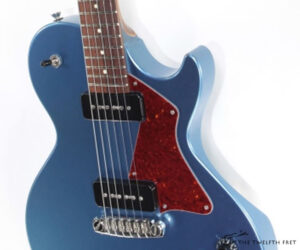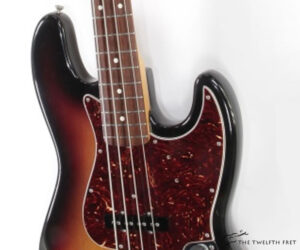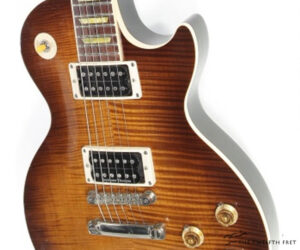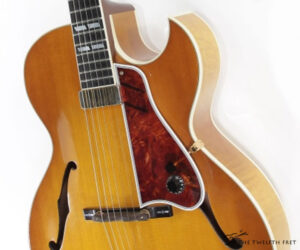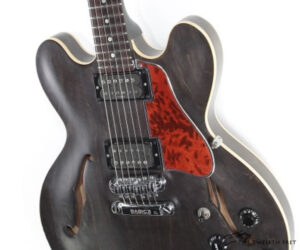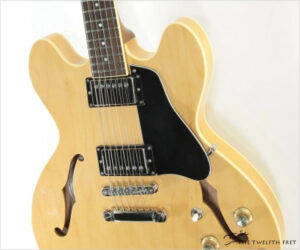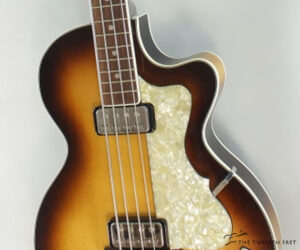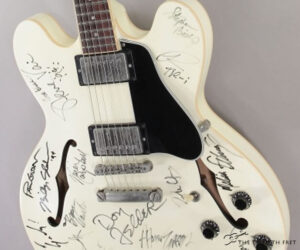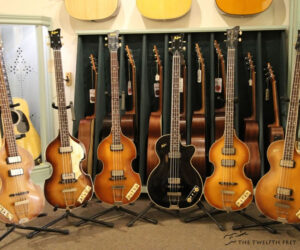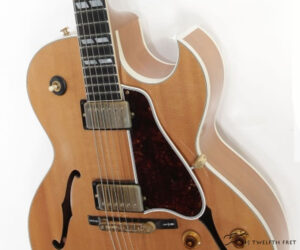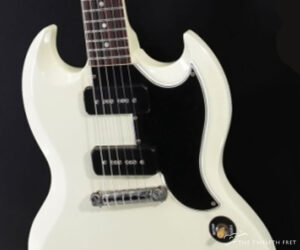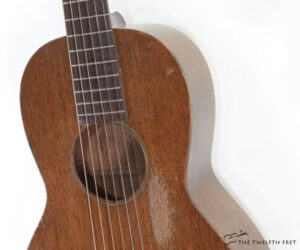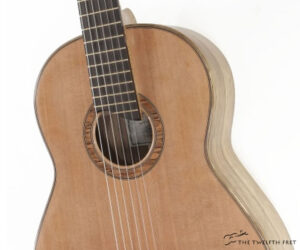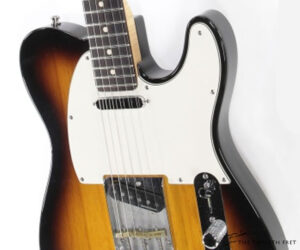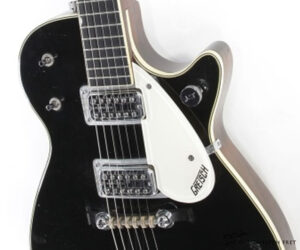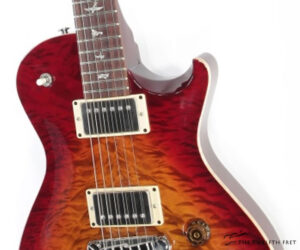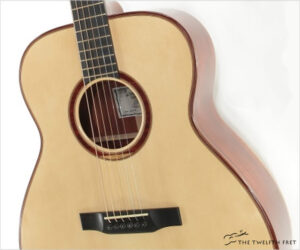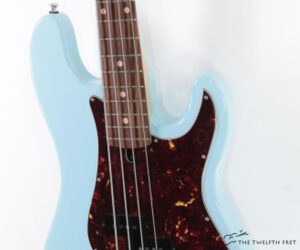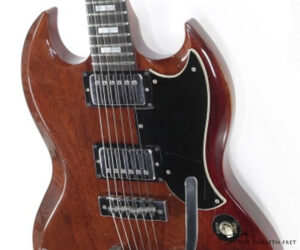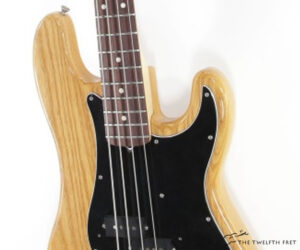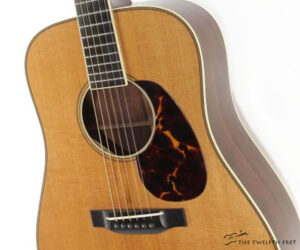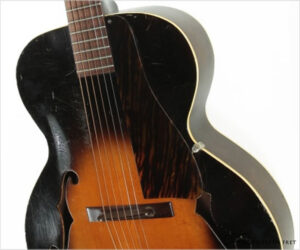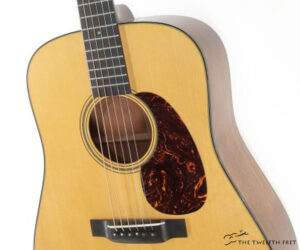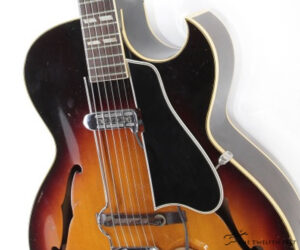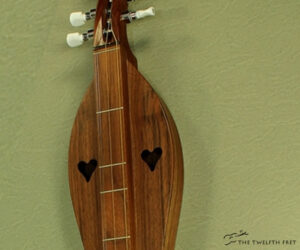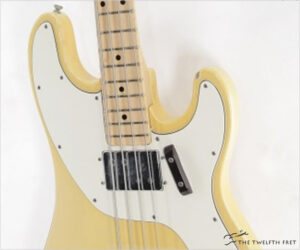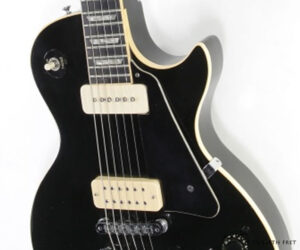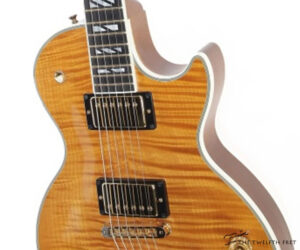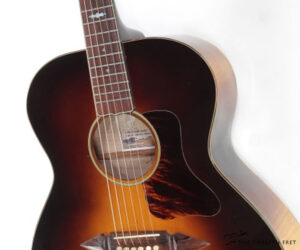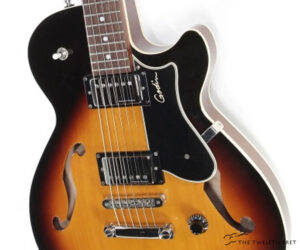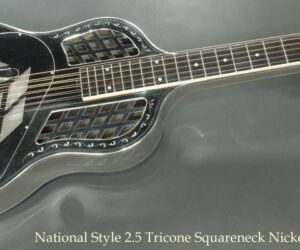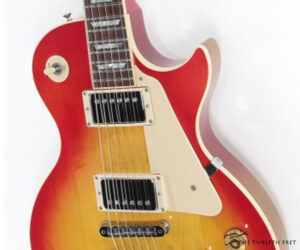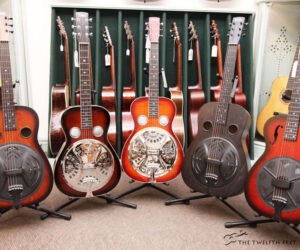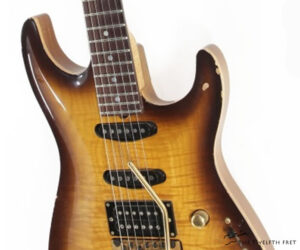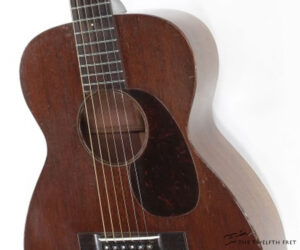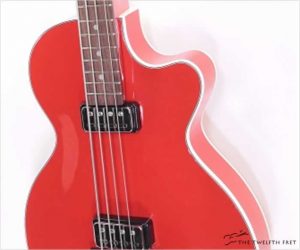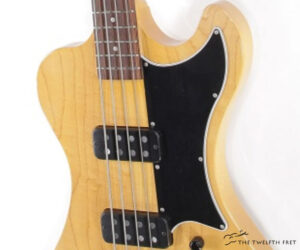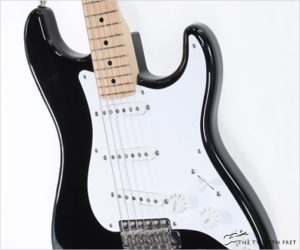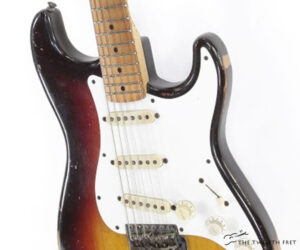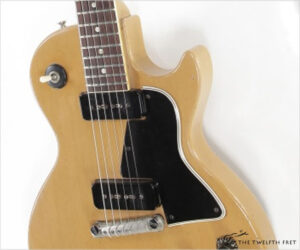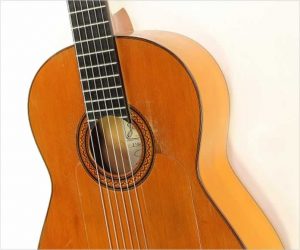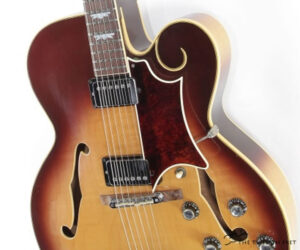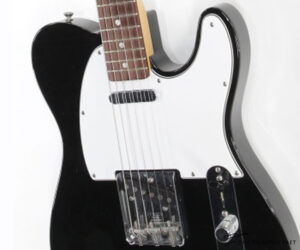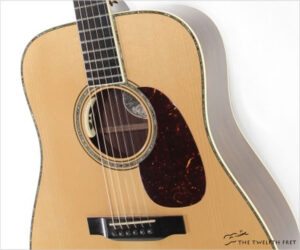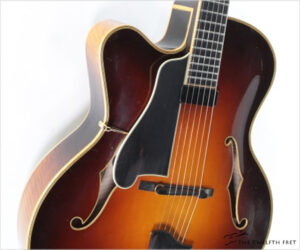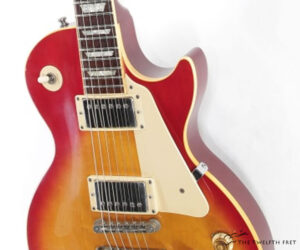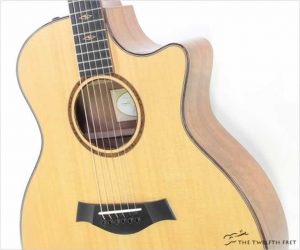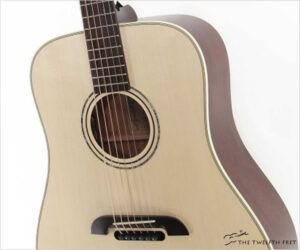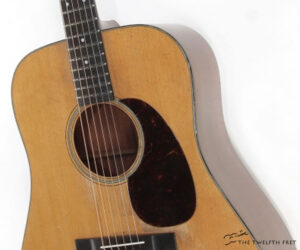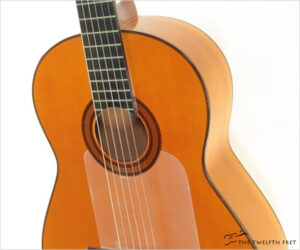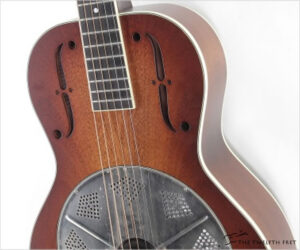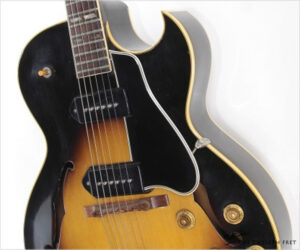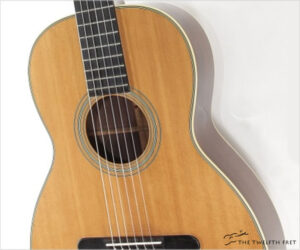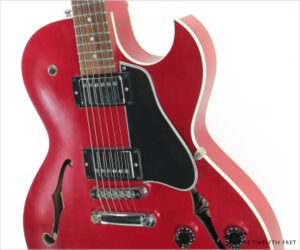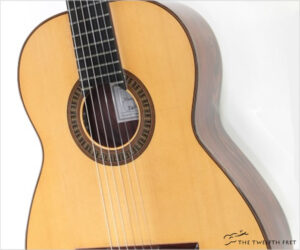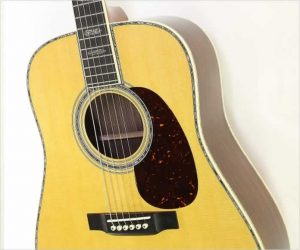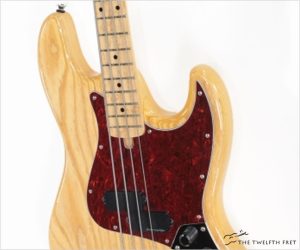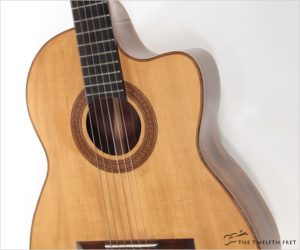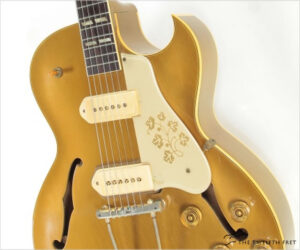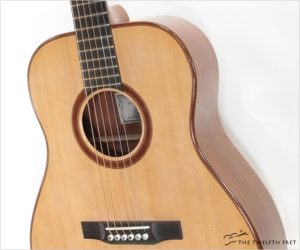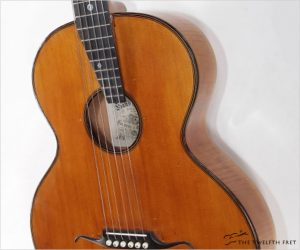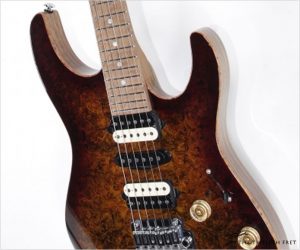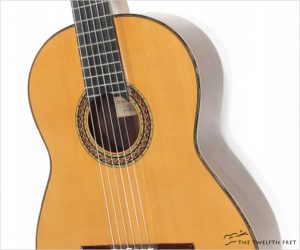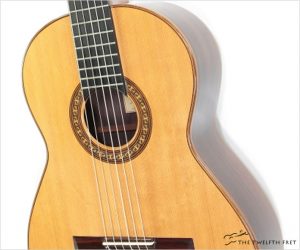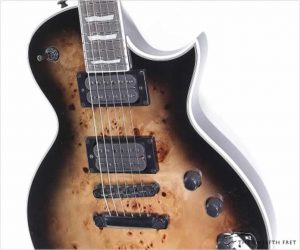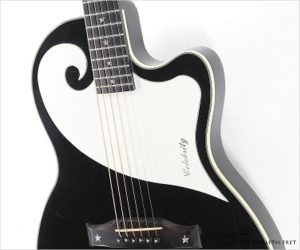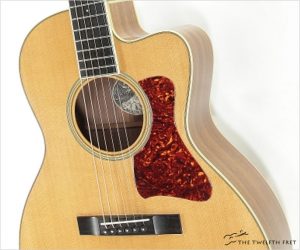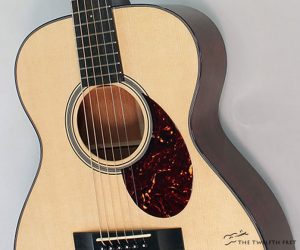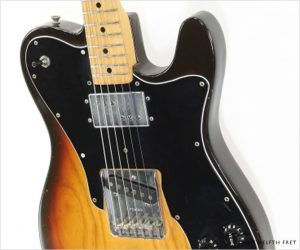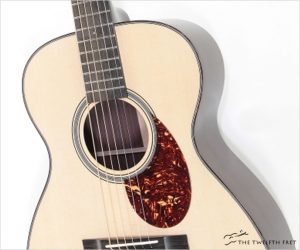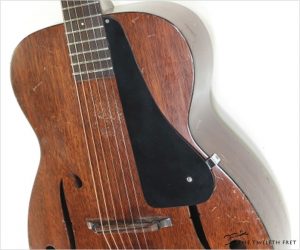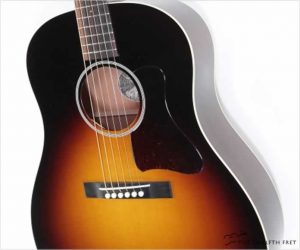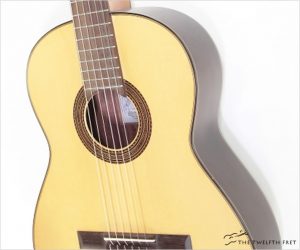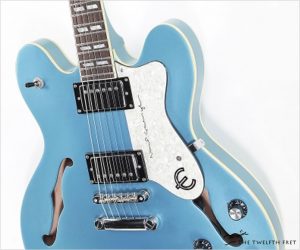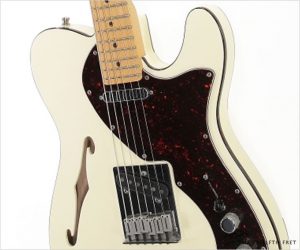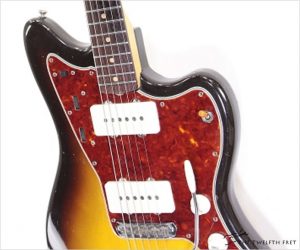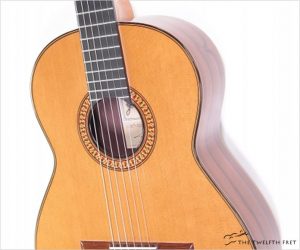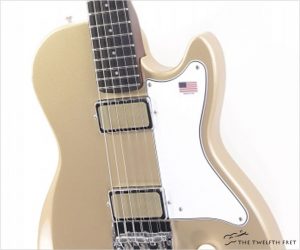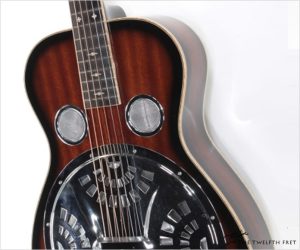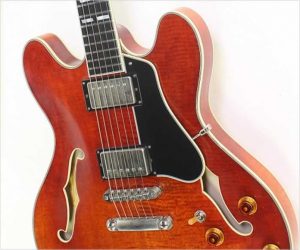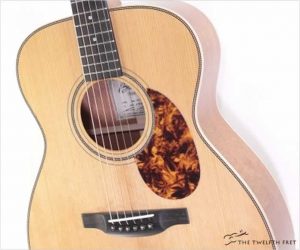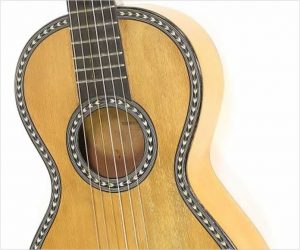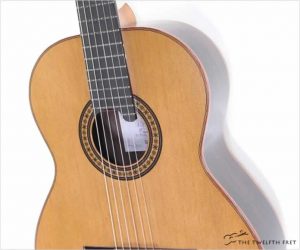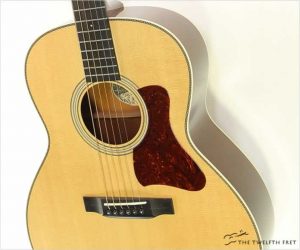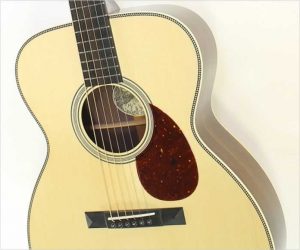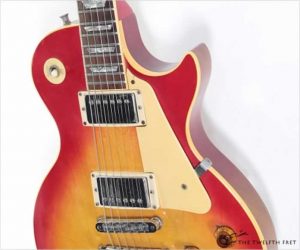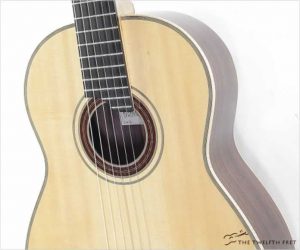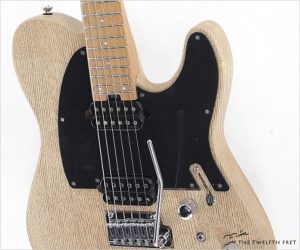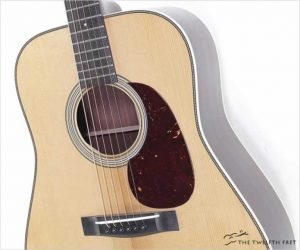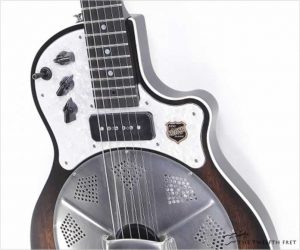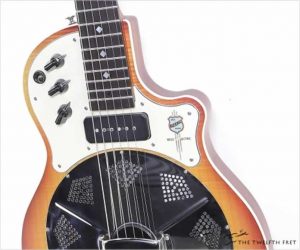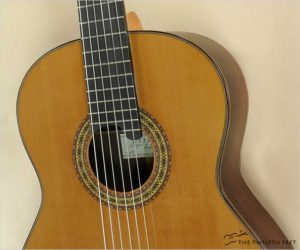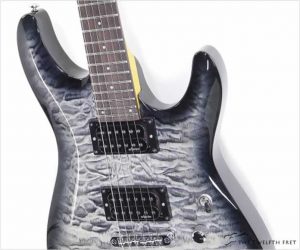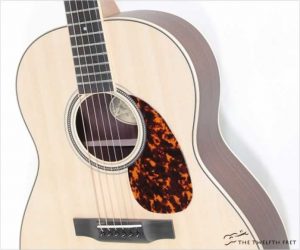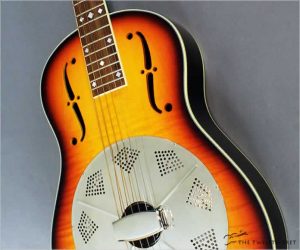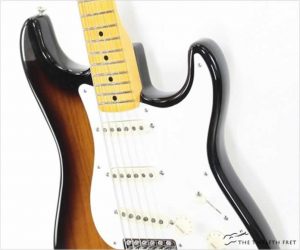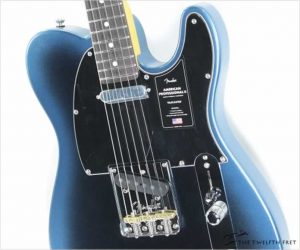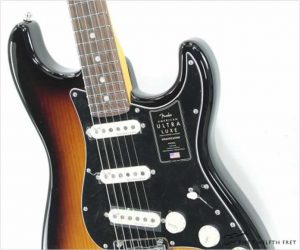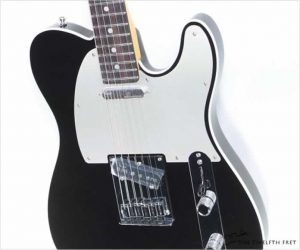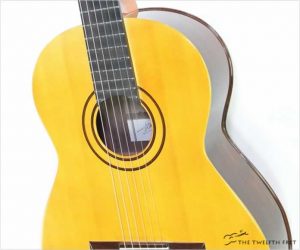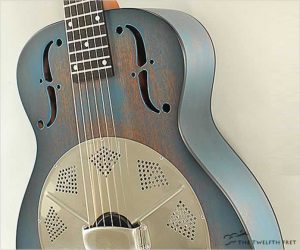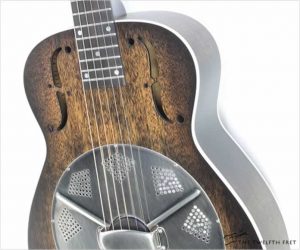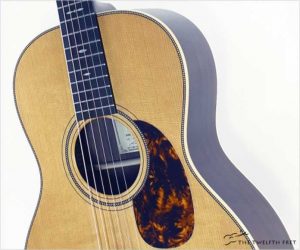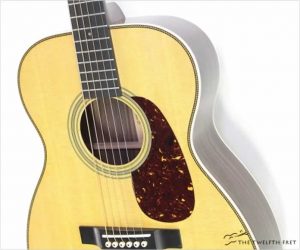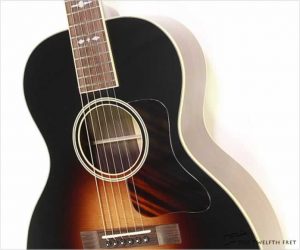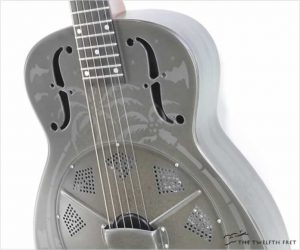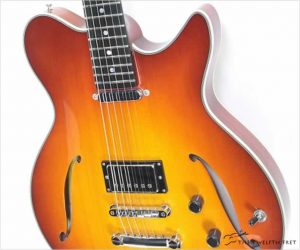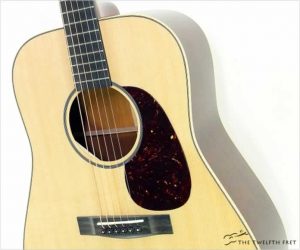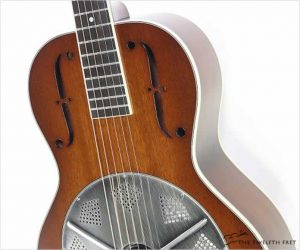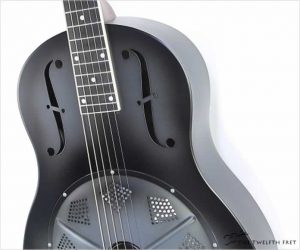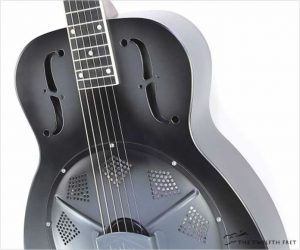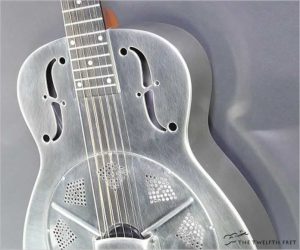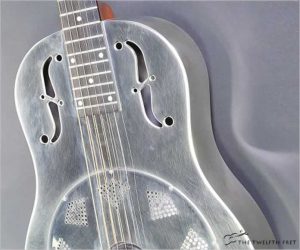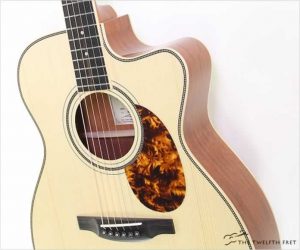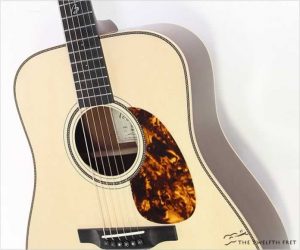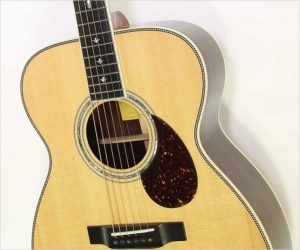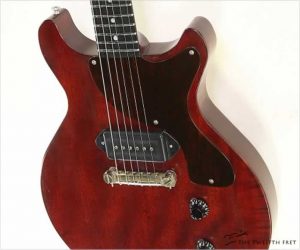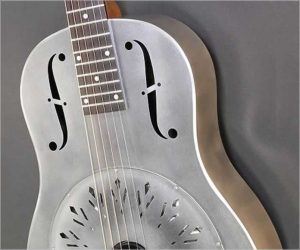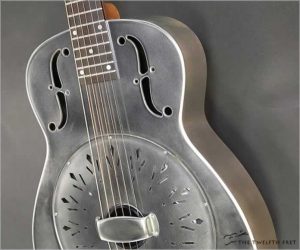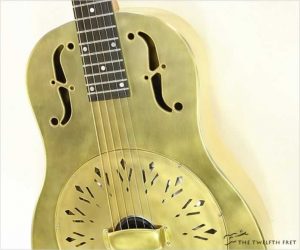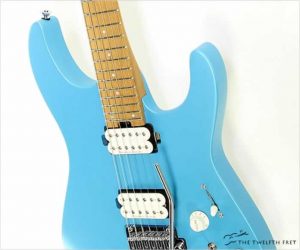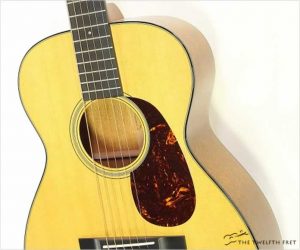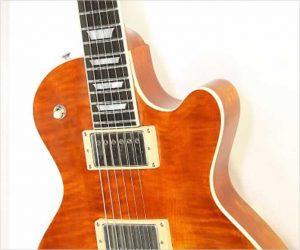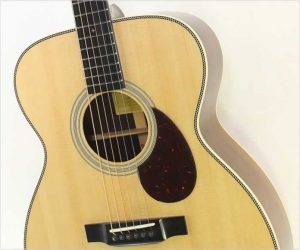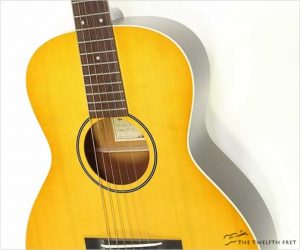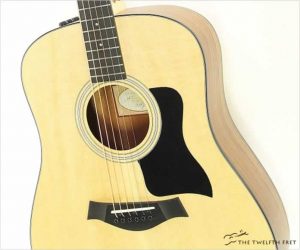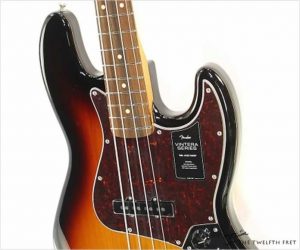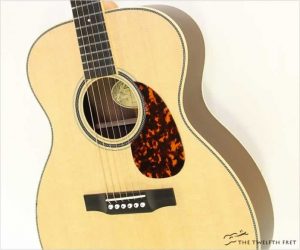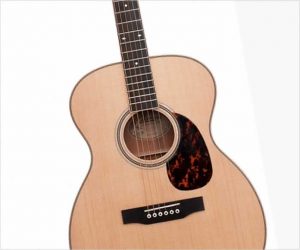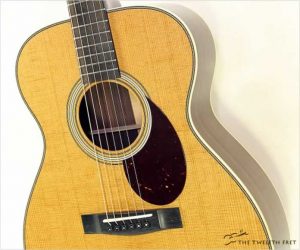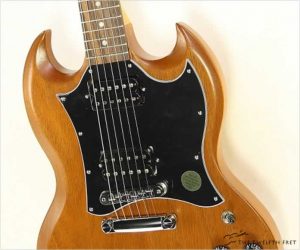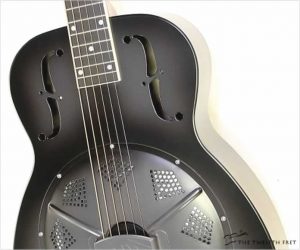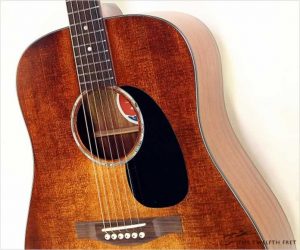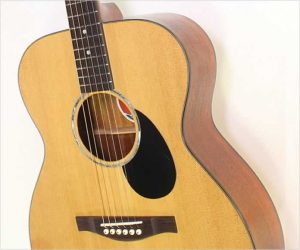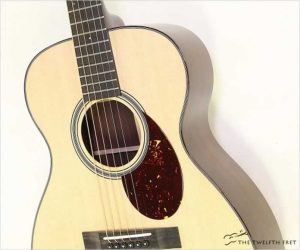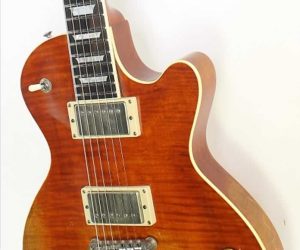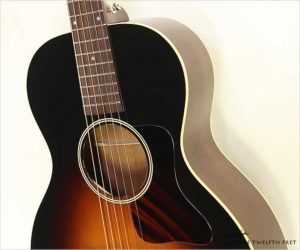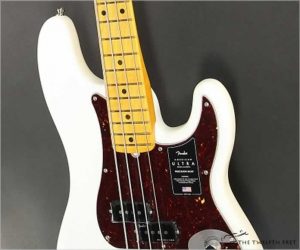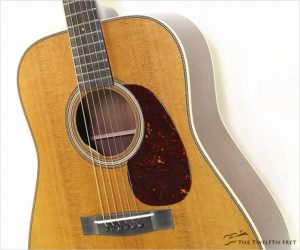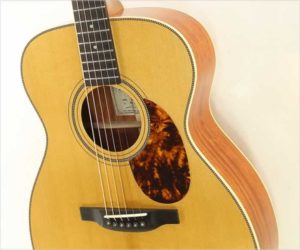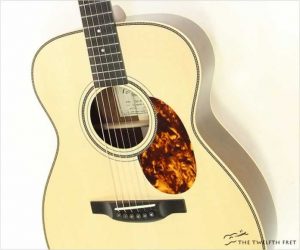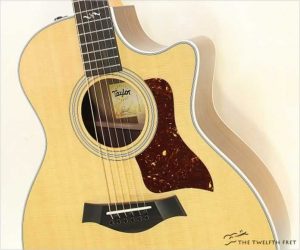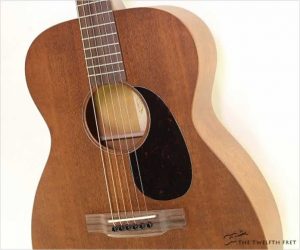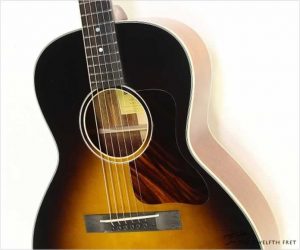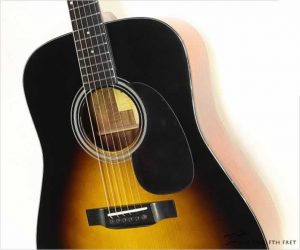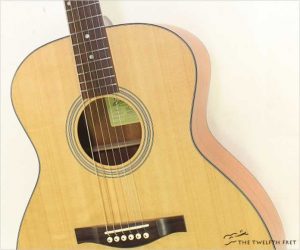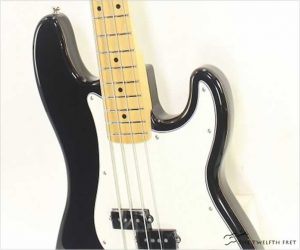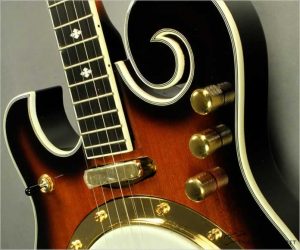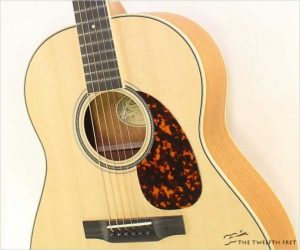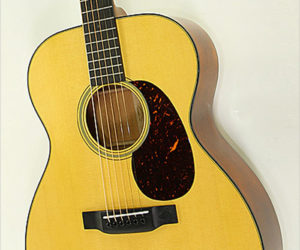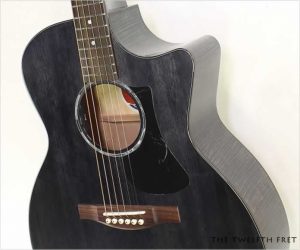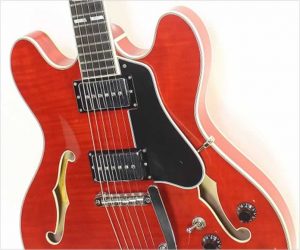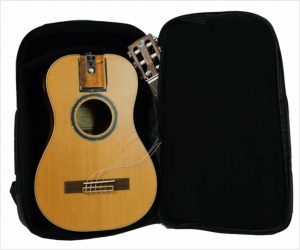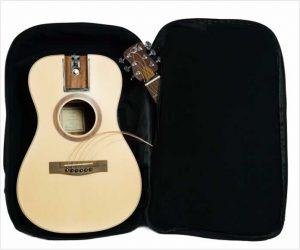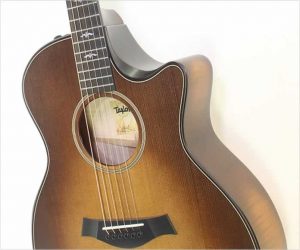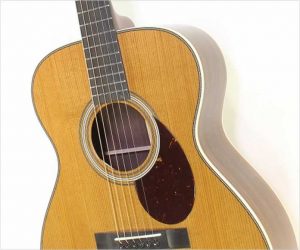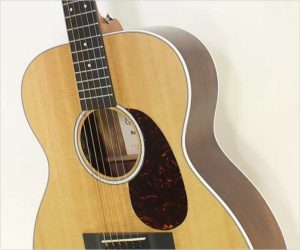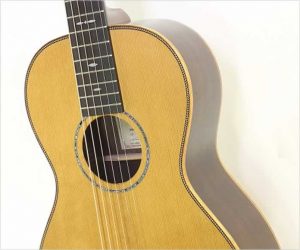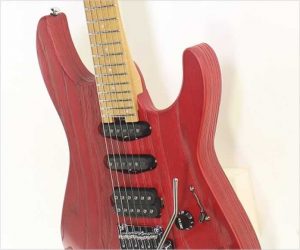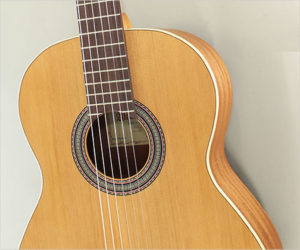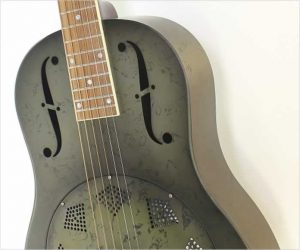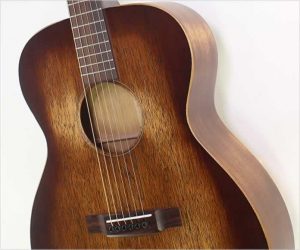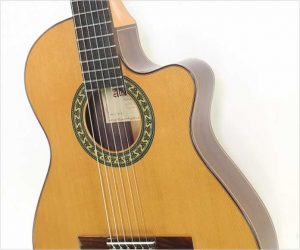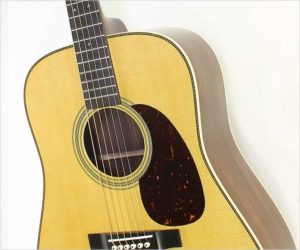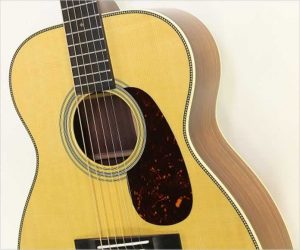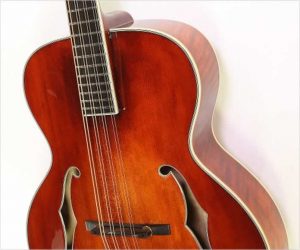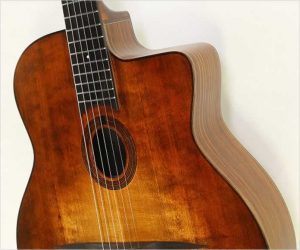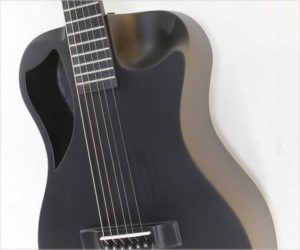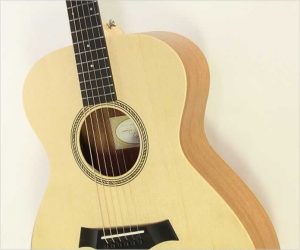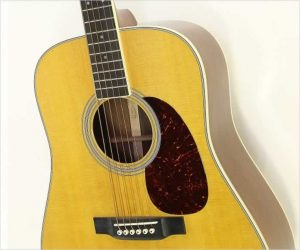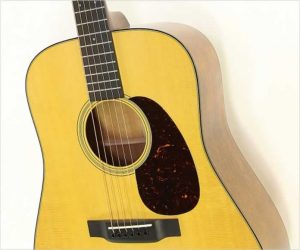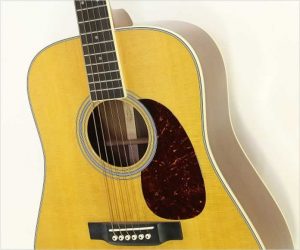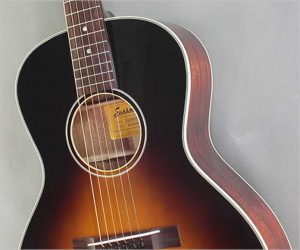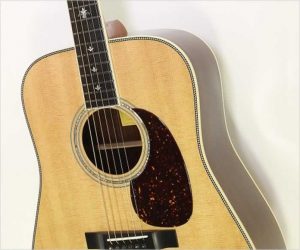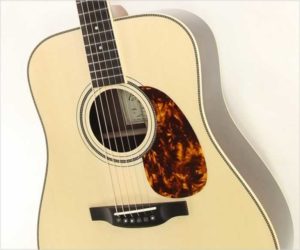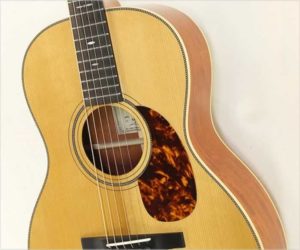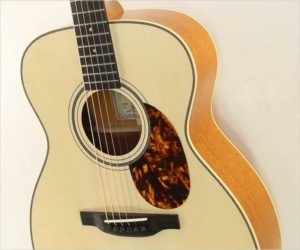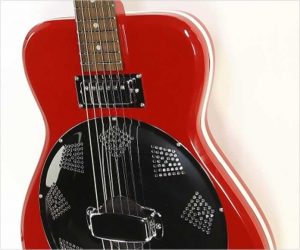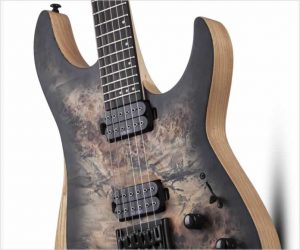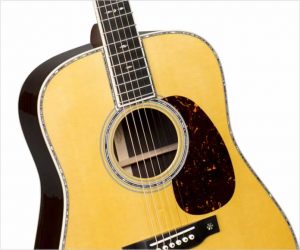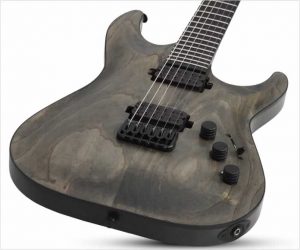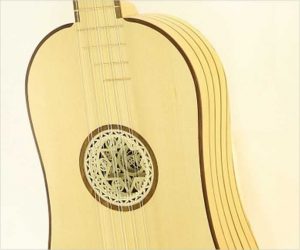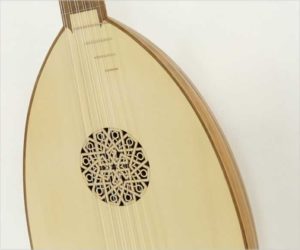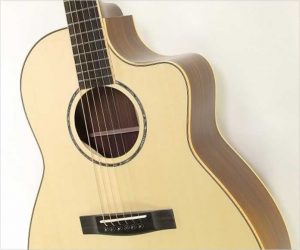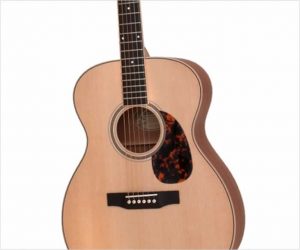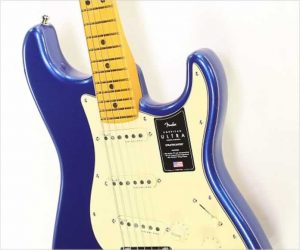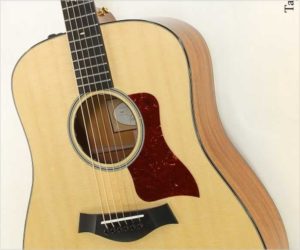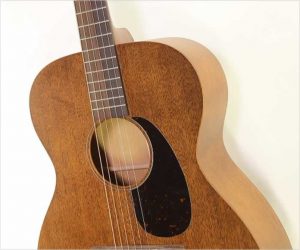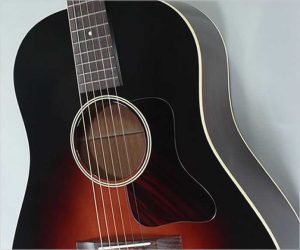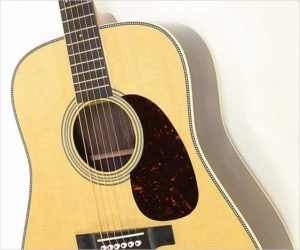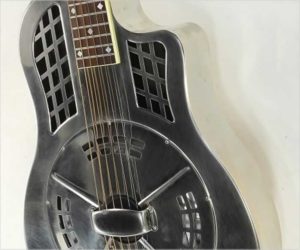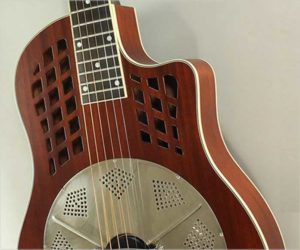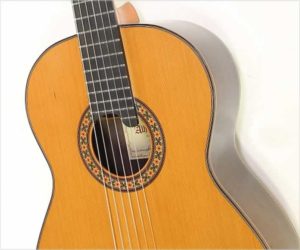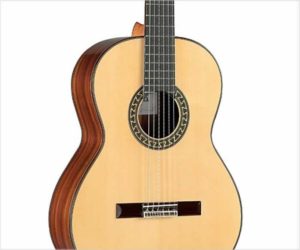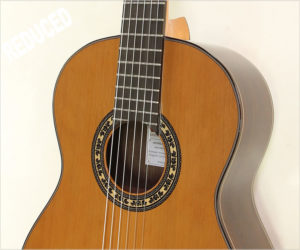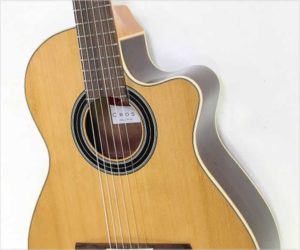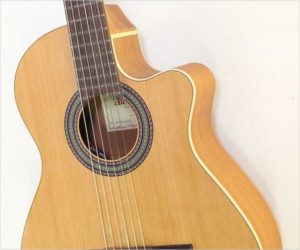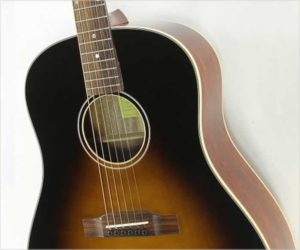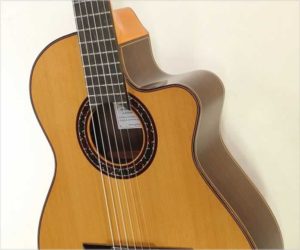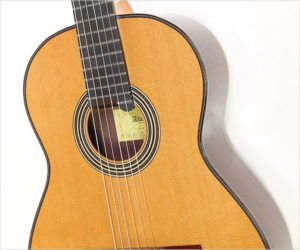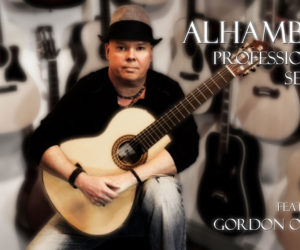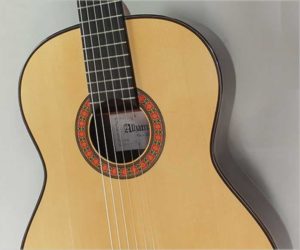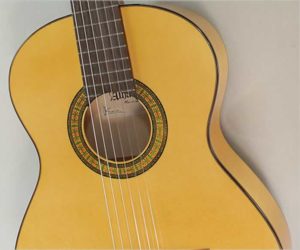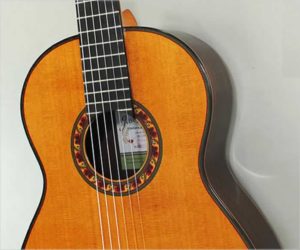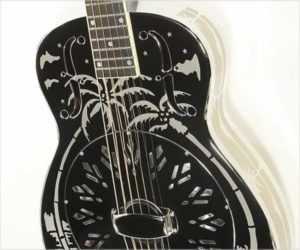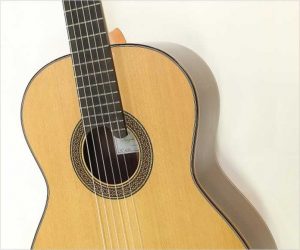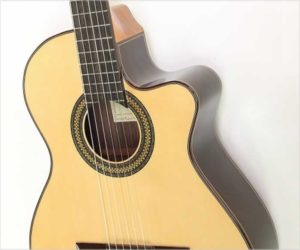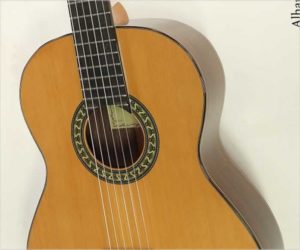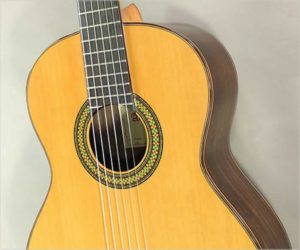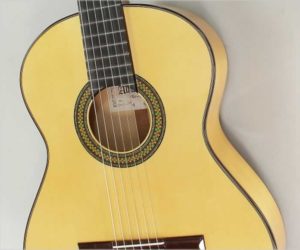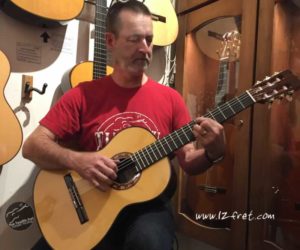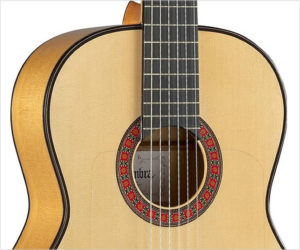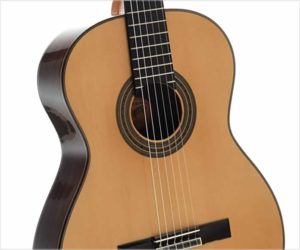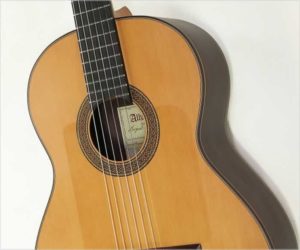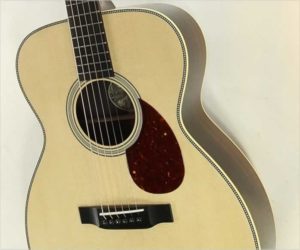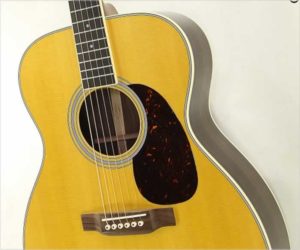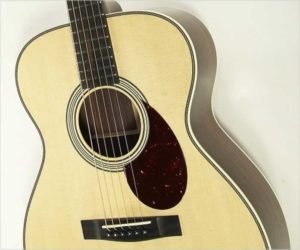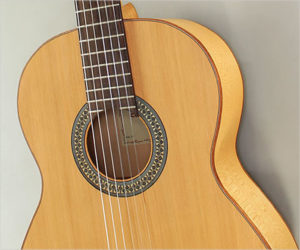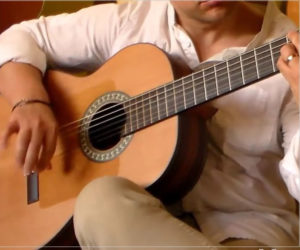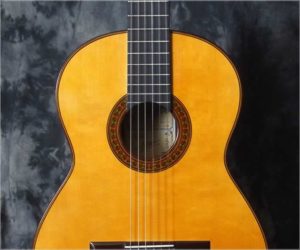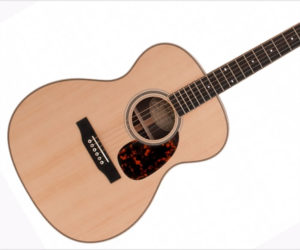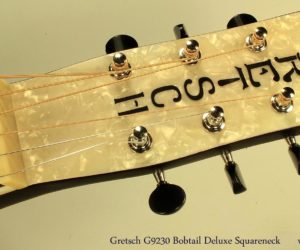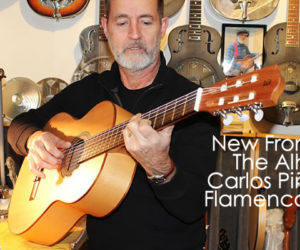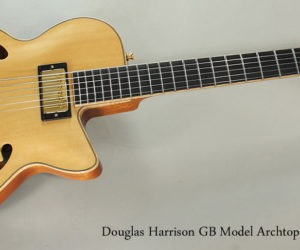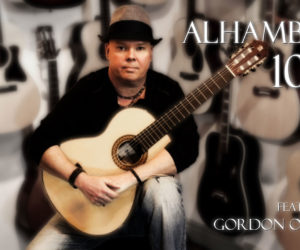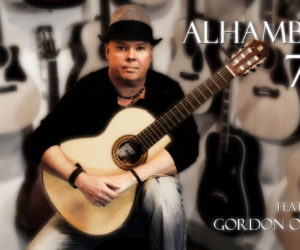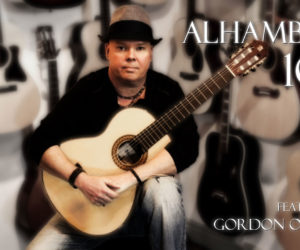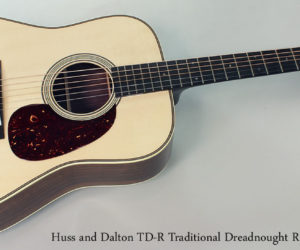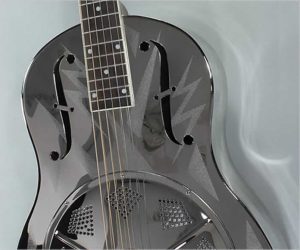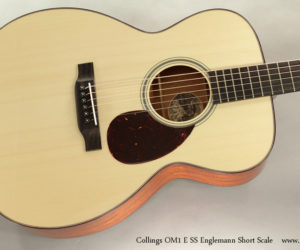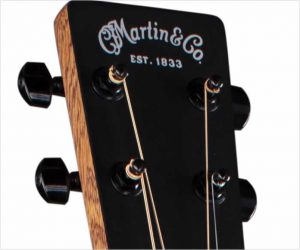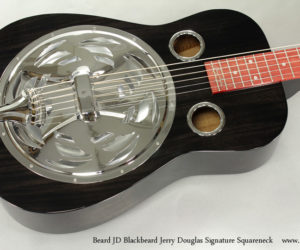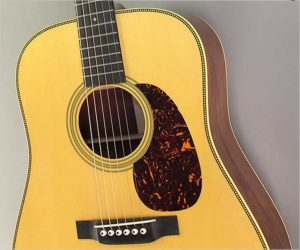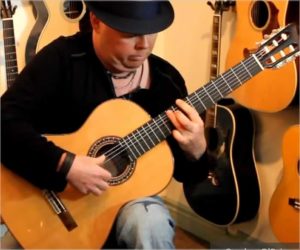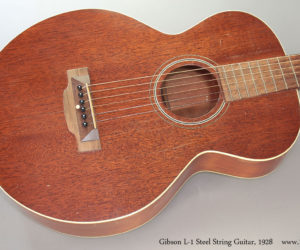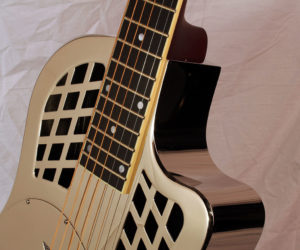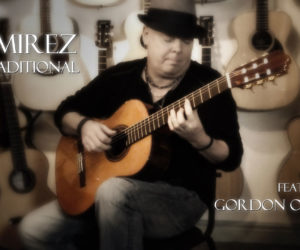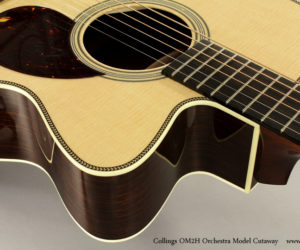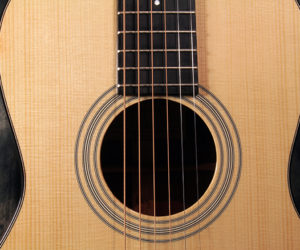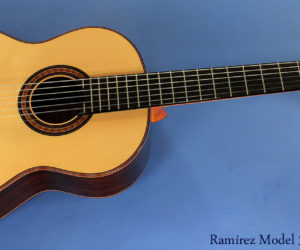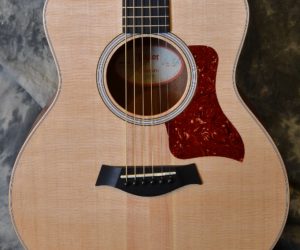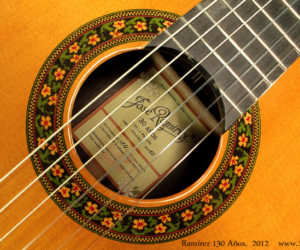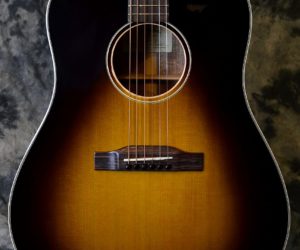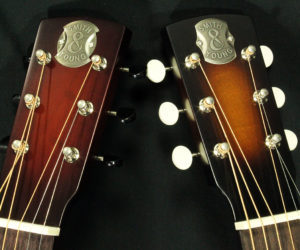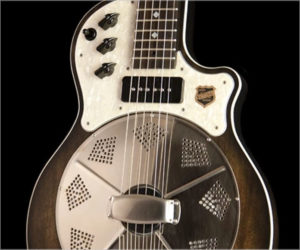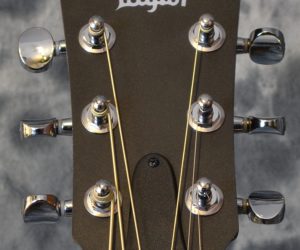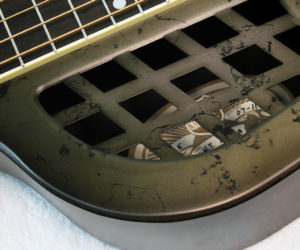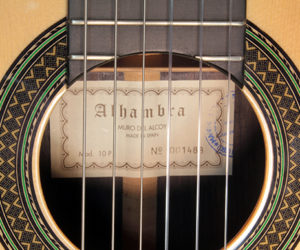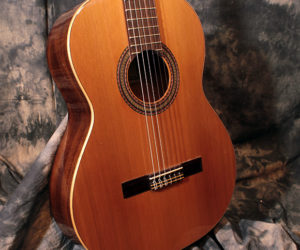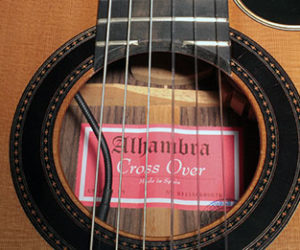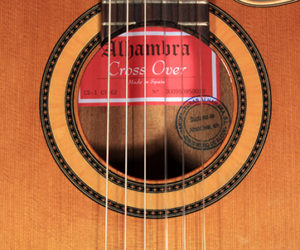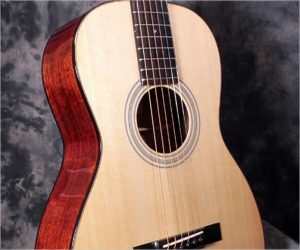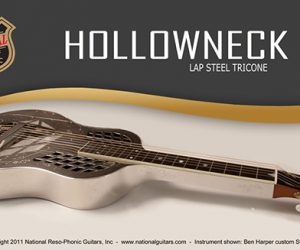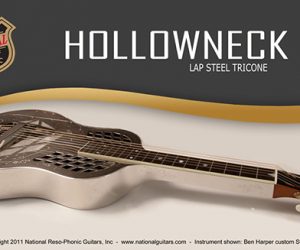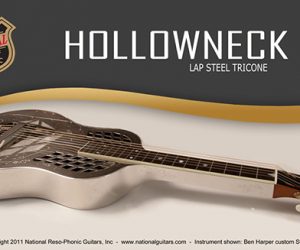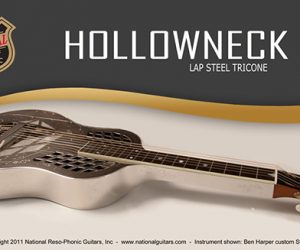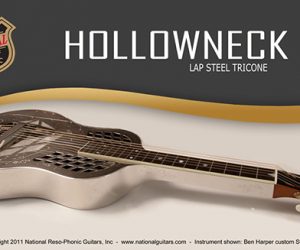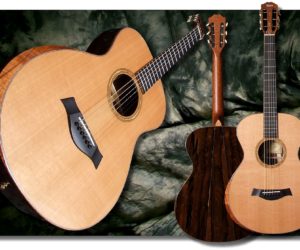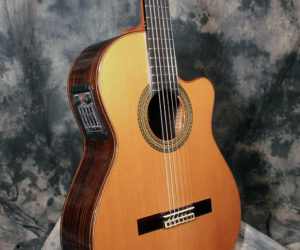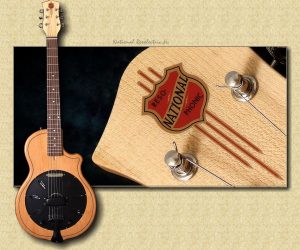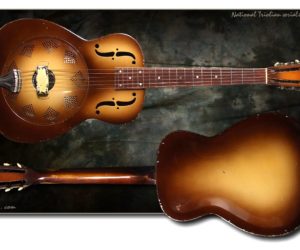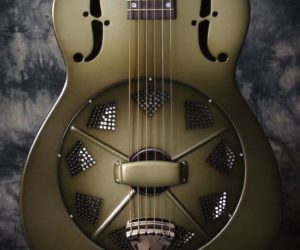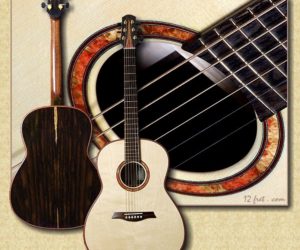While the source of the name given to this Collings 290 may seem obvious as it’s got two P90 pickups, it’s really a reference to the road outside the Collings shop. Drawing from a few traditional solidbody models, the 290 was launched in 2006 at the NAMM show, and has been in production since. Built during 2018 in Austin Texas, this Pelham Blue Collings 290 has some differences from current production.
Guitars
The Fender American Vintage ’62 Jazz Bass was built from 1999 to 2002. As part of the American Vintage series, this bass reprises the early specifications of the highly influential successor to the revolutionary Precision bass.
The Gibson Les Paul Classic Premium Plus was built from 1993 to 2001 as a high end version of the Classic, which provided the slimmer 1960 neck profile. As with other higher end Les Paul models, the body features a Mahogany back with a highly figured, bookmatched Flame Maple cap, Mahogany body and Indian Rosewood fingerboard.
When originally introduced in 1912, the Gibson L-4 appeared as a 16 inch wide, oval hole archtop, switching to F-holes in 1935. The cutaway body L-4C appeared in 1949 and by 1956 had displaced the non-cutaway model. In Gibson’s naming convention, the ‘C’ was dropped some years ago.
For 2006, the Memphis plant introduced the Gibson Satin 335, a somewhat stripped down version of the classic design. Most noticeably, the fingerboard was unbound and the finish is satin – sunburst, cherry or translucent black as seen here. Later versions seem to have restored the fingerboard binding. These models were discontinued with the Memphis plant itself in 2019.
Here is an excellent Epiphone Elitist ES-335 /NA in Natural finish, built during 2006 at the Terada plant in Nagoya, Japan. This is the same plant that builds many pro-line guitars, including Gretsch models, and this guitar illustrates the quality of their work. The Epiphone Elitist ES-335 is based on an early 1960’s Gibson ES-335 with dot position markers, but it is not an exact copy.
The Hofner Club Bass, also known as the Hofner 500/2 bass, is very similar in design to the iconic 500/1 Beatle Bass, but with a traditional single cutaway ‘Club’ body. Originally built between 1965 and 1970 for Selmer, the Club bass has had a number of prominent appearances on stages; Tina Weymouth of Talking Heads used one for several tours.
Conceived as ‘The Ultimate Signature Guitar,’ this autographed Gibson ES-335 Dot, conceived in 1991, boasts a striking Alpine White finish adorned with signatures from renowned guitarists. Originally donated by Gibson, this guitar became a centerpiece for a signature collection themed around the ‘Most Important Guitarists of the Last 10 Years,’ as chosen by readers of GUITAR Magazine in 1993.
A wide range of new Hofner Reissue Violin and Club Basses are in stock at The Twelfth Fret! Seen here are six brand new Hofner reissue 500/1 and 500/2 basses with reliced Varnish and Nitrocellulose Lacquer finishes.
Here we’re looking at a Gibson L-4CES (CES for Cutaway Electric Spanish) in Natural lacquer finish, dating to January 11 1989 and built at Nashville. This example is in overall very good, clean and original condition with light wear to the back finish and very light fret wear. The gold plating on the pickups shows typical wear to the bass edge, but the bridge, tailpiece and tuner plating has very little wear.
Built from 1991 to 2003 in Memphis, the Gibson ES-135 P100 was a single Florentine cutaway, semi-hollow thinline with a pair of P100 hum-cancelling pickups. From 1956 to 1958, the ES-135 existed as a renamed ES-130, a full-depth, single-cutaway archtop with one or two P-90 pickups. The ES-130 was introduced in 1954, renamed in 1956 to the ES-135, and discontinued in 1958.
The 2007 Gibson SG Special VOS replicates the 1961 style, with a pair of P90 pickups and Classic White finish. Currently this model is offered as the 1963 SG Special Classic White Ultra Light Aged. Like the SG itself, the SG Special originated as a Les Paul model, officially renamed in late 1963 at the end of Les Paul’s endorsement contract
Here we’re looking at a Martin 2-17 #25 built during early 1930 in Nazareth, Pennsylvania, showing a 1929 feature – a straight saddle. Not long after this guitar was built, Martin shifted to slanted saddles, giving the bass strings a little more length for intonation purposes. Apparently 449 were built during 1930 with this saddle, and 50 with the slanted saddle.
Seen here is a new Sergei de Jonge Classical Guitar with an elevated fingerboard, pairing a Cedar top with Black Limba for the sides, back and neck. The bracing is Spruce, the body blocks and linings are Mahogany. The bridge is Indian Rosewood and the fingerboard is Ebony. As is the case for most of de Jonge’s guitars, the finish is a hand-applied French Polish.
From 2006 at the Custom Shop, this Fender Custom American Telecaster sports a sunburst finish and a Glendale bridge plate and saddle set. The Fender Custom American Telecaster starts with a rather full, large ‘C’ profile, AAA grade birdseye Maple neck with an Indian Rosewood fingerboard, paired with a lightweight Ash body.
Here’s a fantastic piece from early 1959, a Gretsch 6128 Duo Jet in Black Top finish. Just after this guitar was built, Gretsch altered the design to add a zero fret to the fingerboard. This is a great looking, playing and sounding guitar. It is one of the lightest electrics available at just over seven pounds (3.2kg), it plays well, and these Filter ‘Tron pickups are very good sounding. Introduced in 1954 just after the solid body, Pine capped 6130 Roundup, the chambered Duo Jet was aimed directly at Gibson’s Les Paul model, with a similar shape but very different yet hidden construction differences.
This PRS SC-245 10 Top in dark cherry sunburst is a thing of beauty, in very good clean and original condition. The SC-245 model has been in and out of production twice, from 2007 to 2009 and then 2013 to 2016.
Here we’re looking at a first-year PRS SC-245 10 Top, built during 2007 in Stevensville, Maryland. Based on the Singlecut body design, this guitar has a spectacular, highly figured bookmatched Quilted Maple top on a Mahogany back.
This Sergei de Jonge Steel String Guitar pairs a Sitka Spruce top with Padauk for the sides, back, head plate, backstrap and rosette. Built during 2018 in Chelsea Quebec, it is in very good, clean condition, and delivers a full, rich and complex sound. Like many guitars from the de Jonge shops, this model has a French Polish finish, providing protection to the woods with a minimal imposition on the guitar’s vibration.
Shown here is a Lakland USA Bob Glaub 44-64 Bass with Rosewood fingerboard and Sonic Blue finish, built during 2017 in Chicago, Illinois. Bob Glaub is a highly experienced American bassist who has long worked with Jackson Browne and many other top rank artists.
Shown here is an original condition Gibson SG Standard with optional Bigsby from 1973, in Walnut finish and originally sold at Mamelok LTD in Manchester, England, which closed in 1993. The Gibson SG Standard launched with the SG name in 1963, but really first appeared in 1961 as a radical redesign of the Les Paul model.
Introduced in 1951 and still in production with relatively minor changes, the Fender Precision Bass is an example of a designer getting almost everything right. Immediately, it almost completely displacing the upright bass it was intended to challenge, and it has become one of the most-used and most-recorded instruments in history.
This spectacular Bourgeois Custom D LSH Large Sound Hole, 2015- is part of a series of instruments offered around the 2015 Summer NAMM show. Dated to June 5, 2015 at Lewiston Maine, this pairs an Adirondack Spruce top with premium Brazilian Rosewood for the sides, back and head plate.
The Cromwell G-4 archtop guitar was built by Gibson from 1935 to 1939 and sold to various retailers and catalog distributors. Inside this guitar, visible through the bass F-hole is a well-preserved yellow label reading ‘New York Band Instrument Company’ indicating that it was sold by that company, at the time a large music store in New York City, but gone by 1950.
Built around February of 2015, this Martin D-18GE 1934 Golden Era Dreadnought sports an Adirondack Spruce top and a Natural finish. Martin’s Golden Era D-18 models were first built during 1995 and based on a 1937 model. From 1999 to 2016, they were based on a 1934 model, and then replaced by the Authentic series.
Seen here is a Gibson L-4C cutaway archtop acoustic guitar with an original DeArmond Rhythm Chief 1100 pickup with its ‘Monkey on a Stick’ mount. This fine vintage guitar very much looks the part, and it plays well. The 16-inch wide Gibson L-4C was introduced in 1949 and came to replace the non-cutaway L-4. That model first appeared in 1912 as an oval-hole archtop, with F-holes becoming available in 1935 and finally discontinued in 1956.
The McSpadden Mountain Dulcimer Company of Arkansas made their first mountain dulcimer in 1962. The Mountain dulcimer has been popular on the folk scene for many decades. We have just started to detect a renewed interest in this easy-to-play historic instrument and have imported an exceptional quality American hand made example that features solid Walnut construction with geared tuners, heart shaped sound holes and a carved scroll peghead!
While the source of the name given to this Collings 290 may seem obvious as it’s got two P90 pickups, it’s really a reference to the road outside the Collings shop. Drawing from a few traditional solidbody models, the 290 was launched in 2006 at the NAMM show, and has been in production since. Built during 2018 in Austin Texas, this Pelham Blue Collings 290 has some differences from current production.
The Fender Telecaster Bass launched in the surprisingly late year of 1968, though its appearance is very much like the original, revolutionary 1951 Precision Bass. From a modern perspective, there isn’t a lot to the Fender Telecaster Bass.
The Gibson Les Paul Pro Deluxe was built from 1978 to 1982 and blended features of several previous Les Paul models. Based on the Les Paul Deluxe, the Pro Deluxe had P-90’s in place of mini-humbuckers, a Maple neck and Ebony fingerboard with trapezoidal position markers.
Introduced in 2003 and built at the Nashville Tennessee shop, the Gibson Les Paul Supreme is a high-end take on the classic design and features carved, highly figured Maple top and back. The construction of the Gibson Les Paul Supreme differs from the standard Les Paul though it uses the same basic materials as the Les Paul Custom. The carved top and back set are bookmatched, highly flamed Maple, on either side of a chambered Mahogany core
Here is a rarity! A John Greven Prairie State Model ‘Doug Jones Special’ jumbo steel string from the early 2000’s. This beautiful piece is built with a Spruce top, Flame Maple for the back, sides and neck, and Brazilian Rosewood for the bridge and bound fingerboard. The binding, heel cap, head plate and pickguard are faux tortoise. Tuners are Waverly open gear models with creme plastic buttons.
Introduced in 2013 at the winter NAMM show, the Godin Montreal Premiere HT has a thin trestle-braced arched top body and is ideal for jazz players. This Godin Montreal Premiere HT example is in very good, clean condition, dates to the first months of 2016 and was built at the Godin shops in La Patrie, Quebec with a mixture of domestic and imported woods. The top, back and sides are locally sourced Wild Cherry laminate with a Trestle or ML bracing system that supports and damps the body while reducing weight, and provides anchor points for the stop tailpiece.
The National Style 2.5 Tricone Squareneck, or ‘Style Two and a Half’ is very close to the Style 2, with just a rose engraving on coverplate’s hand rest making the difference. Introduced in 1927, the Style 2 was the top of the National line, with a brass body with nickel plating. The wooden components, such as the headstock, are Mahogany, except for the Ebony fingerboard. National Resophonic guitars were a radical, major innovation in musical instrument design.
Here’s a Gibson Les Paul Standard Cherry Sunburst dating to October 22, 1980, sporting a Cherry Sunburst finish and a non-weight relieved, non-pancake body! The Les Paul model was introduced in 1952 as Gibson’s entry into the then-new solidbody ‘Spanish’ electric guitar field, where ‘Spanish’ refers to the way the guitar is held.
New Beard resonator guitars in squareneck and roundneck models, including the new Radio Standard line have arrived! The Radio-E comes standard with Beard #14 spider and hand spun Beard Legend Cone™, a black tailpiece and black Radio™ coverplate. All Radio Standards come standard with Gotoh tuners. The Radio-RFB comes standard with a hand spun Beard biscuit cone and a black tailpiece and black sieve coverplate.
Shown here is a Pensa Custom MK-1 built during 1995 in New York City by Rudy Pensa. The MK designation stands for Mark Knopfler. The original MK model was designed by Pensa and Knopfler to create a guitar capable of sounding like the 1961 Strat and 1958 Les Paul Knopfler was using on stage, allowing him to use only one guitar.
The Martin 0-17 has at least two major distinctions, as one of Martin’s oldest defined styles, and their first production steel string model. Martin’s Style 17 first appeared in 1874 as a fairly plain model, and was discontinued from 1898 to 1906.
Here’ s a new, old stock 2015 Hofner Gold Label Club Bass in solid red! The Club Bass is also known as the 500/2 – the 500/1 is the iconic violin shaped ‘Beatle Bass’. This is a ‘Gold Label’ model, one of a limited edition in custom colour. These models are built at the primary Hofner plant in Hagenau, Bavaria and are not always easy to find available for sale.
The Gibson RD Artist Bass were built during 2018, revisiting the original RD Basses from 1977 to 1981. These distinctive basses draw from Gibson’s original Firebird and Thunderbird designs, but are definitely not copies. The early RD Bass line consisted of two models, the Standard, and Artist. Construction was Maple for the body and Laminated Maple for the neck, with a Maple fingerboard.
Here is a Fender ‘Blackie’ Eric Clapton Signature Stratocaster which was built during 2008 and is in great original condition. This model, introduced in 2004 and built by a team (as distinct from one master builder) features an Alder body and soft-V 22-fret, 9.5 inch radius Maple neck, with a Custom Shop logo and Clapton signature above ‘Blackie’ on the back of the head.
Showing distinct signs of having been used as intended, this Fender Stratocaster Sunburst was built during 1958 in Fullerton, California. Introduced in 1954 as the successor to the Telecaster, work on the Fender Stratocaster began in 1951.
The Gibson Les Paul Special TV model appeared in 1955, with the ‘TV’ referring to a special ‘limed’ finish intended to make the guitar more visible on black and white televisions and films. This finish had become available in 1954 on the Les Paul TV, a single-pickup Les Paul Junior. Both models used a slab Mahogany body with no Maple cap, and a Mahogany neck, with a bound Rosewood fingerboard, which into the mid 1960’s meant Brazilian Rosewood.
Ramirez 1a flamenco guitars are built in the traditional Spanish style at the ‘home’ workshop. The guitar centers on a ‘slipper foot’ neck to body joint, with the sides fitting into slots cut into the heel block. The body pairs a Spruce top with Cypress back and sides – a very light wood in terms of weight and colouring, also providing a lot of brightness to the tone.
This Gibson Tal Farlow is a rare model. Named after the renowned jazz guitarist Tal Farlow, who played Gibson guitars throughout the ’50s where this model was designed to meet Farlow’s demands for a guitar that combined superb playability with a rich, resonant tone.
This Fender 67 Tele Closet Classic sports a period correct Rosewood fingerboard and was built during April 2005 in Corona, California. Built to original 1967 specs pairing an Ash body with an Indian Rosewood Maple neck, this guitar also includes all original style hardware – the Schaller made F-stamped tuners, Ashtray style bridge and custom shop pickups.
Combining classic D body construction and ’42’ style trim, this 2007 Collings D-42A dreadnought pairs Adirondack Spruce with Indian Rosewood. This sonic cannon delivers much more than good looks and top quality construction. Now out of production, the Collings D-42A sat at the top of Collings’ ‘Traditional’ line.
The Eastman AR910CE LH – Left Handed – is pretty much the top of the Eastman line of archtop electrics, with solid wood throughout and carved top and back. It’s fairly unusual to see an available high quality left-handed archtop. The top and its bracing are solid Spruce, paired with nicely flamed and matched Flame Maple for the sides and back.
Presented here is a splendid 1993 Gibson Les Paul Standard, thoughtfully enhanced with a host of wiring and hardware upgrades. This meticulously preserved instrument retains all of its original components, while introducing noteworthy improvements.
Here’s a great deal on a New, Old Stock (NOS) Taylor Custom GA in Spruce and Figured Walnut, dating to early 2015 and at a significant price reduction! As the name suggests, the Taylor Custom GA is from Taylor’s Custom programme, sometimes known as BTO or ‘Build To Order’. The GA stands for Grand Auditorium, one of the larger body sizes but smaller than a Jumbo or Dreadnought.
The Alvarez DYM60HDE is based on a guitar designed and built for Jack Pearson, a highly respected American guitarist and once a member of the Allman Brothers Band, and sits at the higher end of the Alvarez line since its introduction around 2018.
Seen here is a wartime (WW2!) Martin D-18 Dreadnought, built during 1943 at Nazareth PA and in great playing condition. Accompanied by a recent appraisal from George Gruhn, this piece is in structurally very good condition with wear expected for over 80 years of use. The back of the head does not have a ‘Made in USA’ stamp, which was typically used to identify guitars built for export, particularly to Canada.
Here is an historic piece – one of Lenny Breau’s Ramirez 1a Flamenco Guitars, built during 1961 and used during many appearances with Lenny as seen in the attached clips. The first clip is from is a CBC documentary from 1968 with Lenny playing the guitar with its distinctive friction tuners, and the visible, protective tap plates (Golpeador). Note the technical deviation from ‘strictly traditional’ Flamenco style – the use of a thumbpick, very likely a Chet Atkins influence.
Designed in collaboration with Mike Dowling, the National Mike Dowling Signature El Trovador is a single cone guitar patterned after the famous National El Trovador between 1932 and 1933. The National Mike Dowling El Trovador guitar features a large, 4 inch deep body built from mahogany laminate with a wooden soundwell for the resonator.
The Gibson ES-175D was formally introduced in 1953 as the Double P-90 pickup version of the single-pickup ES-175. Informally, a few were shipped in 1951 and 1952 but without the ‘D’ designation. This guitar came onto the scene in 1949 as a single pickup archtop with a sharp Florentine cutaway, Maple laminate body construction, Mahogany neck and Rosewood bridge and bound fingerboard.
The Martin 00-28C was the top of Martin’s classical guitar line, featuring Brazilian Rosewood back and sides and a fan-braced Sitka Spruce top. The fingerboard and bridge are Ebony, with Mahogany for the body blocks and neck. The bracing is Spruce, and the neck attachment style is a dovetail joint.
The Gibson ES-135H was the ‘Humbucker’ equipped version of the ES-135, a single-cut Semi-Hollow Archtop built in Memphis from 1991 to 2004. Many of these models used P-100 pickups – a stacked humbucker with the outline of a P-90. Some models used a Trapeze tailpiece, others as seen here a standard Tune-O-Matic and Stop Tailpiece combination.
This Vicente Carrillo Pasion Flamenco Negra model, was built during 2014 in Casasimarro, Cuenca Spain where his family has built since 1744; Vicente is the seventh generation. Casasimarro is roughly between Madrid and Valencia, about 220km southeast of Madrid. Vicente Carrillo has been building instruments all his working life.
The Martin D-45 has been the top of the line in the Martin Guitar Company’s line of regular production instruments since its initial introduction in 1933, and its re-introduction in 1968.
This Overwater Scott Devine Model 4 J Series Bass dates to 21 August 2017, and features a Swamp Ash body paired with a 33 inch scale Birdseye Maple neck. It also includes Overwater’s own active electronics, powered by a single 9v battery.
This Bruce West Cutaway Classical guitar, bearing the serial 16-1 and built during 2016 in Sterling, Ontario features a hundred year old Swiss Alpine Spruce top and Brazilian Rosewood sides and back. Like Bruce’s other guitars, this tie into an interesting and pivotal period of Canadian luthiery history.
This is a wonderful rarity. Built during 1953, this is an early Gibson ES-295 in good, clean and largely original condition, showing some honest finish wear and tear from real use over the decades. It’s easy to confuse the Gibson ES-295 with the classic ES-175, and there’s a good reason – they are the same guitar, but the ES-295 has a double gold finish and when introduced, two pickups instead of one.
This de Jonge Standard Spruce and Sapele Steel String guitar with natural French Polish finish is dated to 2021. A lovely, new older stock de Jonge Standard steel string features a Sitka Spruce top with with Sapele (Entandrophragma cylindricum) for the rosette, sides, back and head plate.
Here we have a Hans Raab Munich Style Guitar built of Spruce, Maple and Ebony during 1916 in Munich, Germany – during WWI. Hans Raab and his son built many instruments in a wide range of styles, from the mid 1880’s to World War II. They were well known for not just the number of instruments built and their variety – their catalog was apparently quite large – but also for the quality of their work.
Here we have a spectacular Suhr Custom Modern Plus with a Burled Maple cap finished in Bengal Burst on an African Black Limba body and Roasted Maple neck. This beautiful, very well built Suhr Custom Modern Plus is in nearly new condition with only the slightest wear. The stainless steel frets show no signs of wear, and the finish is near pristine.
Here is a wonderful rarity – a Manuel Rodriguez Sr. Classical guitar, built during 1969 in Los Angeles of Spruce, Brazilian Rosewood and flamed Maple. Manuel Rodriguez Sr. was born in Madrid in 1926 and began learning guitar building from his father, and both worked for Jose Ramirez II. Manuel opened his own shop in 1955, but in 1959 moved to Los Angeles, where this guitar, #308, was built.
This Sergei de Jonge Classical guitar was built during 1980 in Toronto, following de Jonge’s return to Canada from a year in Holland and creation of a new workshop. Having learned guitar building in Toronto during the years 1969 to 1971 from Jean Larrivee and Edgar Monch via Eli Kassner, and then a year with Patt Lister in Collingwood, this de Jonge classical shows these strong influences.
The LTD EC1000 in Black Natural Burst is designed by ESP in Japan and built in Indonesia. This is a well designed and built modern take on the single-cutaway carved top solidbody guitar concept. This model uses Mahogany body with a burled Poplar top, and a ‘Set-Through’ neck joint for the 3-piece Mahogany neck.
The Gibson Chet Atkins Celebrity SST was built from 1991 to 1993 as a version of the CEC – the Chet Atkins Classical, solidbody nylon string guitar.
The Collings C10 Deluxe Cutaway fits into the range of ‘Parlor’ guitars, slightly smaller than the OM or 00/000 body sizes. The cutaway is offered as an option, with the base model being a traditional non-cutaway design. The top and bracing is Sitka Spruce, the sides and back Indian Rosewood, the body blocks and neck are Mahogany and the bridge, head plate and bound fingerboard are all ebony.
The Huss and Dalton T-0014 Traditional 00 14 Fret is a spectacular guitar. The 00 body design is very well balanced and articulate, and wonderful for finger style playing. The Huss and Dalton T-0014 is built with a Sitka spruce top, mahogany back and sides, and ebony for the fingerboard and bridge.
The 1970’s Fender Telecaster Custom was a significant departure from the 1960’s Custom, which had basically been a stock model with a bound body. In contrast, the Telecaster Custom introduced in 1972 and built until 1979 introduced the head-end “Bullet” truss rod adjuster, the three-bolt MicroTilt neck angle adjuster, and a huge change for Fender – the Wide-Range Humbucker designed by Seth Lover.
The Huss & Dalton T-OO14 is a fantastic mid-size steel string acoustic guitar, based on the classic ‘OO’ body size. This design dates to 1877 as a 12-fret gut string instrument, and evolving into the steel-string, 14-fret model in 1932 as banjo players moved to guitar.
Listed from 1935 to 1941, the Martin R-17 was one of a few arched top, flat back models in the Martin catalog, featuring a Mahogany top, back and sides. Its sibling, the R-18, had a solid, shaped Spruce top with Mahogany elsewhere; Brazilian Rosewood was used for the head plate, bridge, and fingerboard. Early examples of both models used 12 fret necks but soon gained the more popular 14 fret configuration.
Here we have a brand new and spectacular Collings CJ45 T Slope Shoulder Dreadnought in a sunburst lacquer finish! Based on the classic J-45, the Collings CJ45 T Slope Shoulder Dreadnought takes that design to what’s probably its ultimate expression. Top quality woods and materials are used by extremely skilled workers, and the result is wrapped in one of the consistently best finishes available.
Here is an unusual item! Built during 2014 in Guanajuato, Mexico, this is a J Perfecto Rubio Estudio model; the builder is a cousin of famed luthier German Vazquez Rubio of Los Angeles, who worked for Bernardo Rico when B C Rich models were new. We do not see many Mexican-built guitars in Canada, and in that number, high quality models like this are even rarer.
Influenced heavily by the Sheraton used by Noel Gallagher in Oasis, the Epiphone Supernova was built from 1997 to 2005, with a signature pickguard and features making it the Noel Gallagher Supernova. It was available in a variety of finishes including the Manchester Blue seen here, and a custom Union Jack graphic.
The Fender Thinline Telecaster was introduced in 1969 as a design by Roger Rossmeisl, who had done major work for Rickenbacker. There have been a few versions of this model, and this particular 1998 example seems to me one of the best ever.
The Fender Jazzmaster appeared halfway through 1958, targeted at jazz artists, the group Fender hadn’t fully won over. One of the key features of the Fender Jazzmaster was the introduction of a Rosewood fingerboard on the Maple neck. To this point in time, Fender necks had been a single piece of Maple with a rear Walnut ‘Skunk Stripe’ covering the truss rod channel.
The concert-grade Ramirez Traditional Professional 1a Model is the “benchmark guitar” for tone and quality for Maestros, performers and Master-Luthiers world-wide. Considered by many to be the Ultimate Concert guitar, the traditional is available in Red Cedar top and by special order in German Spruce top. The Ramirez 1a Professional is built with Indian Rosewood back and sides. We also offer it in artist-grade Madagascar Rosewood back and sides.
This Harmony Jupiter in a cool Champagne nitrocellulose lacquer finish is a retro solidbody guitar built in Kalamazoo, Michigan. The Jupiter marks the return of what was at one time of the world’s largest instrument manufacturers. The Harmony Jupiter’s classic looks and well-rounded tonality make it a perfect match for any style or genre.
The Beard Legacy R RoundNeck features a small Mahogany body and neck with Ebony fingerboard, with a single-cone spider-type resonator set. This example dates to 2008 at Hagerstown, Maryland and includes a factory-installed pickup, custom built by Beard with Jerry Douglas and Larry Fishman.
The Eastman T59 V is a take on one of the most successful and influential of Ted McCarty’s innovations, the thinline, semi-hollow archtop electric guitar. Around 1957, Gibson was looking to update its product line to address a number of issues, one of which was the rise in amplified stage volumes causing feedback. While the engineering team is credited with most of the design, it was apparently president Ted McCarty’s idea to put a solid Maple block through the center of the guitar.
The Boucher SG-41 Studio Goose uses the OM (Orchestra Model) Hybrid body shape, modified to work better with fingerstyle playing. A locally harvested Adirondack Red Spruce top is paired with Brazilian Mahogany to provide clear, crisp tone and immediate response. The neck is South American Mahogany, and Ebony is used for the headplate, fingerboard and bridge. Bindings are Maple with Herringbone purfling.
Here’s something special, a lovely Romantic Era guitar built by Francois Tachet in Mirecourt, northeastern France, during the 1830s or early 1840s. Mirecourt has long been known for making musical instruments and lace; instruments from the area are often referred to as from the Mirecourt School. Louis Panormo was a contemporary, working in London. This Francois Tachet romantic guitar – at approximately 185 years old – is in good working order, and has had some expected service over the decades.
The Alhambra Luthier Aniversario is at the top of the line, featuring Ziricote for the sides, back, bridge and head plate, and either Red Cedar or Spruce for the ‘Japanese House’ braced top. The Alhambra Luthier Aniversario line was introduced in 2015 for Alhambra’s 50th anniversary. Built in Muro de Alcoy alongside other models, the Alhambra Luthier Aniversario is built in the traditional Spanish style, with the Ziricote sides tying into the Spanish Cedar (Cedrela odorata, which is neither Spanish or a Cedar) neck block.
The Collings C100 is a full size steel string acoustic with ‘Parlor’ type dimensions, providing great representation throughout the sonic range. Available in two versions, the Collings C100 series starts with the model seen here, pairing a Sitka Spruce top with Honduran Mahogany for the sides, back, body blocks and neck. The head plate, fingerboard and bridge are ebony. The Collings logo and position markers are Mother of Pearl.
Here is a brand spankin’ new Collings OM2H ESS – an Orchestra Model with Engelmann Spruce top, 24.875 inch Short Scale guitar. Based on the classic Orchestra Model design developed at the end of the 1920s and in the Martin catalog for 1930, the Collings OM2H ESS is pretty much as good as it gets. Collings quality is consistently very high, from wood selection to nitrocellulose lacquer finish, setup and everything in between. These are some of the finest instruments available anywhere.
Here’s a Gibson Les Paul Standard Cherry Sunburst dating to October 17, 1980, sporting a Cherry Sunburst finish and a non-weight relieved, non-pancake body! The Les Paul model was introduced in 1952 as Gibson’s entry into the then-new soldibody ‘Spanish’ electric guitar field, where ‘Spanish’ refers to the way the guitar is held. Solidbody Hawaiian models had been available for some time, and Gibson had been producing electrified archtop guitars since the 1936 ES-150.
The Bernhard Kresse Modern Classical guitar blends elements of modern guitar building with traditional practices and techniques, delivering a superior concert grade instrument. This example was built during 2003 at Kresse’s small shop in Köln, Germany and features a Spruce top paired with Indian Rosewood for the sides, back, head plate, backstrap and bridge. Mahogany is used for the body blocks and back braces, Maple for the neck and Ebony for the fingerboard.
The new Charvel SoCal Style 2 has arrived, featuring an Ash T-style body with a licensed reverse-Tele headstock, a pair of Fishman humbuckers, and a 2-point trem! The Charvel SoCal Style 2 Ash body also features a scalloped lower back bout and shredder’s cut heel for easier upper fret access and hours of grin-inducing playing-feel and performance.
The Huss & Dalton TDR is, as the name breaks down, a Traditional Dreadnought design with Rosewood for the sides, back, and head plate. This Huss & Dalton NOS TDR Custom is a New Old Stock model but still covered as new! Built in Staunton, Virginia, the Huss & Dalton TDR evokes the best of the traditional Dreadnought design. Extremely well built and finished, the TDR seen here – a Custom version – uses a Thermo-cured Adirondack Spruce top, paired with Indian Rosewood for the sides and back.
Built in San Luis Obispo California, the National Resolectric Revolver blends the resophonic and solidbody electric guitar concepts, to great success. Very similar in design to the ResoLectric, the National Resolectric Revolver uses a solid Mahogany body that’s routed for the resonator and electric pickups, and a bolt-on Mahogany neck with Rosewood fingerboard. The headplate is a faux pearl covering.
Built in San Luis Obispo California, the National Resolectric solidbody guitar Sunburst blends the resophonic and solidbody electric guitar concepts, to great success. Very similar in design to the Resolectric Revolver, the National Resolectric uses the familiar pairing of a flame Maple top on a Mahogany body that’s routed for the resonator and electric pickups, and a bolt-on flame Maple neck with Rosewood fingerboard. The headplate is a faux pearl covering.
The Alhambra Luthier Rio Concert Classical Guitar is an excellent instrument, available only on special order. It features a Master Grade cedar top and solid Brazilian rosewood back and sides. The name of the model, ‘Rio’, comes from the Spanish name for Brazilian Rosewood – Palosanto de Rio. The Alhambra Guitar Company of Muro de Alcoy in Spain have built a reputation for crafting high quality nylon string guitars used extensively by students, educators and professional musicians.
The Schecter C6 Plus is a straight ahead, no-nonsense model providing great looks, playability and tone at a reasonable price. Combining the proven ingredients of a Maple neck with 24-fret Indian Rosewood fingerboard and a Basswood body, the Schecter C6 Plus also sports a top ‘image’ layer of Quilted Maple, finished with a very nice Charcoal Burst finish.
Part of the Larrivee Recording series, the Larrivee L03R is an American made instrument with excellent craftsmanship, tone and value. Back in the early seventies a young Jean-Claude Larrivee created the L body shape which has become a staple of the Larrivee guitar line. This body shape is similar to a classical body design and features a Symmetrical Parabolic X-Bracing pattern.
The Fender American Professional II Telecaster with Rosewood fingerboard and Dark Night finish features rolled edges on a deep C profile neck, narrow-tall frets, heel contour, V-Mod II single-coil Telecaster pickups, and a stock treble bleed circuit to preserve highs when the volume control is turned down. A new bridge design with three compensated brass saddles can be strung either from the top, or the traditional rear-load.
The Brand new Fender Ultra Luxe Stratocaster has arrived! This is one of the first Fender production models to bear Stainless Steel frets. It also has other helpful features like locking tuners, a push-in trem arm and noiseless pickups with the S-1 switch, giving access to all pickup combinations.
Here is the new Fender American Ultra Telecaster Rosewood Board in seen here in the new Texas Tea finish, with new body contours, stock noiseless pickups, new electronics, biflex truss rod, and a compound radius fingerboard!
Here’s a Ramirez Conservatorio Abeto Concert classical guitar, built during 2014 in Madrid, Spain and featuring the ‘Abeto’ or Spruce top.
This example is in overall good condition, with one small pressure mark on the top. It has no cracks and wear is minimal. The original Ramirez-branded Hiscox lightweight flight case is included. The Ramirez Conservatorio Concert Classical guitar represents a major development in classical guitar design from Amalia Ramírez, with unique use of ‘fiddle edge’ construction.
The National M-14T Thunderbox is the latest version of National’s standard M-14 and features a 4″ deep body, delivering more low end and applied volume.
The National M-14T Thunderbox is the latest version of National’s standard M-14. The newly improved M-14T features a 4″ deep body, improving the low end response and creating a louder, punchier instrument. The National M-14T Thunderbox body is composed of laminate top and back, and solid mahogany sides. This instrument also features a mahogany neck, ebony fretboard and mother-of-pearl position markers.
The Boucher HG56 is crafted for the best tonal results. It will deliver mids and bass depth while finger picking even using a capo at the 7th fret. Evenness and richness of sound will surprise the most accomplished players. The ability of this instrument to adjust to your musical style will elevate your playing to the point of your finding it difficult to put it down. Many fingerstyle players have told us that they feel immediately became better musicians as soon as they played our Heritage Goose. This gives us at Boucher Guitars a great sense of pride to help you accomplish your full musical potential and to boost your creativity.
The Martin 0028 has been built for over a century, with the first known example appearing in 1898. The first mention of the 00 body size dates to 1877! Martin’s 00 body was considered enormous when introduced, and was the largest size until the first 000 sized guitar appeared in 1902, followed a decade later by the D body size built for the Ditson company.
Here we have a Huss & Dalton L-13 Standard in Rosewood, based on the classic Nick Lucas models made by Gibson from 1927 to 1938. The L-13 is part of the Huss & Dalton Crossroads line. Featuring a Sitka Spruce top and here with Indian Rosewood for the sides and back, the Huss & Dalton L-13 Standard is also available with Mahogany for the sides and back, while the L-13 Deluxe uses figured Maple and sunburst on the back as well as the top.
Drawing from the roots of the single-cone resophonic guitar, the National Style O Steel 14 Fret definitely has a vintage appearance with all the quality of modern Nationals. Sporting a unique ‘Weathered Steel’ finish over a steel body with rolled F-holes and a Maple neck with Ebony fingerboard, the Style O Steel 14 Fret delivers all the tone, volume and projection that National is known for.
The Eastman Romeo SC is a new limited edition thinline and largely hollow archtop electric design by Otto D’Ambrosio at the Eastman Custom Shop in California. Intended as an imagining of what ‘The Telecaster of the Archtop World’ would be, the Romeo started with defining its balance and player’s hand positions. The body is fairly small at 14.75 inches across, and the ‘Single Cut’ design gives plenty of access to the fretboard.
This is a beautiful brand new Huss & Dalton DM mahogany dreadnought, a great guitar following the traditional pattern of Mahogany D style guitars. Established in 1995, Huss & Dalton began when Jeff Huss and Mark Dalton had the idea to build the guitar they wanted to play. While always appreciating the traditional design, both had a vision of a guitar that paid homage to tradition while incorporating improvements in the structural design and cosmetics of the steel string guitar.
Designed in collaboration with Mike Dowling, the National Resophonic El Trovador is patterned after the famous National guitars produced from 1932-1933. Similar to its venerable predecessor, the new National ResoPhonic El Trovador guitar features a large, 14.5 inch wide, 4 inch deep body built of mahogany. The body is bound in multi-layer celluloid, with a matching purfling border around the coverplate.
The Boucher SG21S comes from Boucher Guitars, who make very high quality hand crafted guitars in the heart of Quebec and their calling card is their use of locally harvested Adirondack Red Spruce. Simple elegance and outstanding quality control are on display when you first observe these fine instruments.
Built in Berthier-sur-Mer Quebec, the Boucher BG152 is a rich, lively and loud dreadnought from the Boucher Bluegrass Goose series of guitars. This impressive dreadnought pairs an AAAA Adirondack Red Spruce top personally selected by Robin Boucher with a lovely set of Madagascar Rosewood. Red Spruce has a high ceiling for tone production which means you can drive a lot of energy with a flat pick or your fingers to produce lots of volume and tone.
The Eastman DT30OM is the second model in Eastman’s new Double Top line, bringing high end classical guitar technology to the steel string world – here in a classic Orchestra Model body design. The double top concept aims to allow a very thin, light and responsive top but with superior strength and stiffness. Here, thin layers of Sitka Spruce are bonded to a honeycomb Nomex core. Nomex is a Kevlar polymer and helps provide significant improvements in stiffness to weight ratios.
Here is an Eastman SB55DC /V Solidbody in Vintage Varnish! This definitely evokes the mid 1950’s slab bodied models, and with top quality hardware. Introduced in mid 2020 and now making its way to us, the Eastman SB55DC /V features a slab body and neck of lightweight Okoume Mahogany, sourced from Gabon, Central Africa. The fingerboard, head plate and truss rod cover are Ebony, and that’s it for woods used.
Charvel guitars have a long standing reputation as the guitar for choice for modern players looking for a fast playing feature laden instrument. The new Charvel ProMod DK 24HH 2PT CM model from the Pro-Mod series boasts a feature set and playability that will rival instruments double the price. The first thing you may notice is the lovely roasted maple neck. In addition to the rich visual aesthetic the process of roasting the maple and taking out moisture makes for a more stable neck that won’t shift as much during seasonal and humidity changes. If you do need to adjust the neck there is a heel mounted truss rod adjustment wheel which makes small changes a breeze.
The Martin 0-18 Standard is a wonderful addition to the standard series from Martin guitars. This parlor sized body features a Sitka spruce top and mahogany sides and back. The small body shape is extremely comfortable to sit with and compact lower bout width helps to decrease strumming arm fatigue. The mahogany neck has a shorter 24.9” scale length and low oval profile to add to the comfortable playing experience.
Though unequivocally drawn from the classic Les Paul design and in particular the most desirable 1959 models, the Eastman SB59V is not a slavish copy. Many visual differences are clear, including the shapes of the headstock and cutaway. The body is constructed of a carved, Flame maple top laminated to a one-piece Mahogany slab body. A Mahogany neck with a bound Ebony fingerboard is attached via a longish tenon joint. The neck has a vintage style ‘V’ profile.
The Eastman E8OM features all solid wood construction and a gloss nitrocellulose lacquer finish. The top, with Herringbone purfling, is Sitka Spruce, the sides, back and headplate Indian Rosewood. The body blocks and dovetail-joint neck are Mahogany, with Ebony for the fingerboard and bridge. Unusually, the fingerboard also appears to have a light coat of clear lacquer. The inlays are subtle, small snowflakes in Abalone. The example seen here is strictly acoustic, but it is available with an L R Baggs pickup system.
The Waterloo WLK TR reproduces a rare, lightweight and responsive depression-era guitar built by Gibson under the Kel Kroydon name from 1930 to 1933. These models are built by Collings at their shop in Austin, Texas. An exceptional instrument, the Waterloo WLK TR features a Spruce top and bracing with Mahogany for the back, sides, body blocks and neck, with an Indian Rosewood 12-fret fingerboard and Ebony bridge.
The Taylor 110e dreadnought guitar features a solid Sitka spruce top which is paired with a layered Walnut sides and back. The body size produces lots of volume and punchy midrange with clear trebles from the spruce top. The very stable maple neck has a slightly narrower 1 11/16” nut width and a satin finish which makes for a very comfortable playing experience. If more volume is needed the Taylor 110e is equipped with the Taylor ES pickup system.
The Fender Vintera 60’s Jazz bass is loaded with features from Fenders Golden era at a more affordable price point. This bass features a mid 60’s C shaped neck carve and a 7.25” radius. The maple neck has a Pau Ferro fretboard and vintage sized frets. The re-voiced 60’s single coil pickups have more of that authentic grit and growl that made the Jazz bass a legend. The open gear tuners, vintage saddles and three tone sunburst finish top really round out the classic aesthetic on this bass.
The Larrivee OM 40R Legacy is simple and elegant orchestra sized guitar that features a Sitka spruce top and Indian rosewood sides and back. The squared peghead with open gear tuners and bold rope rosette and top purfling enhance this classic aesthetic. Top it all off with the ebony fret board and bridge and maple body binding and you have an excellent looking instrument.
The Larrivee OM-40 Legacy model is a tonally well balanced orchestra size flat top with classic appointments. It features a mahogany back and a sitka spruce top. This tone wood combination provides rich midrange warmth and smooth articulation.
Here we have a new Huss & Dalton TOMR Custom featuring a Thermo-Cured Sitka Spruce top and Indian Rosewood back and sides! The model name breaks down to Traditional Orchestra Model Rosewood. On this guitar, the Custom refers to the choice of the thermo-cured Sitka top; it’s also available with an Adirondack or Red Spruce top, and without the thermo-cure. Thermo-cured wood is also known as baked, torrefied, and by Martin as part of their VTS (vintage tone system). The process uses controlled, high heat, atmospheric pressure and minimal oxygen and simulates aging.
The Gibson SG Tribute is part of the Gibson Modern line and is an excellent workhorse guitar with simple and classic aesthetics. This guitar features the classic sg rounded and thin double cutaway body shape made of mahogany. This particular version of the Gibson SG Tribute comes in a satin walnut stain for a very earthy and natural look. The neck is maple with rosewood fretboard and fuller rounded profile and a 12” radius. The satin finish on the back of the neck and the 22 medium jumbo frets provide a smooth and easy playing feel. The double cutaway body design provides easy access all the way up to the last fret.
You will find a superb assortment of Michael Messer Resophonic Guitars at The Twelfth Fret. Our selection include Michael Messer’s array of models.
The PCH1 D model from Eastman guitars is an excellent choice for players looking for great sounding guitar at an affordable price. One of the main features on this model is the solid Sitka spruce top. The top or sound board is one of the main components in tone production on an acoustic guitar. While laminate tops have more durability they are stiff and don’t vibrate well. The solid top vibrates with the energy of the strings and produces tone.
The all-new Eastman PCH1 OM model really hits a sweet spot for players looking for upgraded features at an affordable price. One of the main features on this model is the solid Sitka spruce top, paired with a laminate Sapele body. The top or sound board is one of the main components in tone production on an acoustic guitar. While laminate tops have more durability they are stiff and don’t vibrate well. The solid top vibrates with the energy of the strings and produces tone, and its ability to do this develops over time with playing. This is a guitar that will grow with you!
Here’s a beautiful new Huss & Dalton T0014 Rosewood, part of the Traditional series and here seen with a Rosewood rather than Mahogany body. The top of the Huss & Dalton T0014 Rosewood is Sitka Spruce and the neck is Mahogany, with Ebony for the bridge and unbound fingerboard. The headplate is Indian Rosewood, and there are no electronics installed – this guitar is entirely acoustic.
The Eastman SB59 V reflects the classic late 1950s design for a single cutaway, Flamed Maple on Mahogany solidbody with humbucking pickups. While it follows the formula, it’s not a precise copy and Eastman uses their own designs. As a ‘Vintage’ style model, this guitar has undergone an treatment process to simulate the wear of decades of use – except for fretwear.
Here is a brand new Huss & Dalton Crossroads 12, a smaller bodied, 12 fret version of the Crossroads line. These “Retro” guitars are great for fingerstyle, particularly blues and folk styles, and work really well with a vocalist. Sold with the original Huss & Dalton hard shell case.
The Fender American Ultra Precision Bass is the most advanced offering in their line catering to discerning players that want the most precision, high quality performance and tone. The Fender Precision bass is one of the most heard and recorded bass guitars in history and this version adds some modern features to this legendary tone machine. The alder body and maple neck combination delivers a familiar thump and fat note fundamental. New features include the new ultra-noiseless pickups in a PJ configuration. This gives you a standard precision pickup and a jazz pickup in the bridge position.
The Huss & Dalton TDR is, as the name breaks down, a Traditional Dreadnought design with Rosewood for the sides, back, and head plate. The Dreadnought design first appeared during 1916, built by C F Martin for the Oliver Ditson company. The design was not popular at the time but when Martin re-introduced it in 1931, times had changed. These models went on to great success and are now one of the handful of standard guitar body shapes, built by almost everyone and played by countless guitarists.
The Boucher Studio Goose SG-21 uses the OM Hybrid, or Orchestra Model body shape modified to work better with fingerstyle playing. The very white, locally harvested Adirondack Red Spruce top is paired with African Bubinga to provide clear, crisp tone and immediate response. The neck is Mahogany, and Ebony is used for the headplate, fingerboard and bridge.
The Boucher SG51 is a hybrid style OM guitar that melds simple yet elegant visuals with an inspiring rich balanced tone. Each AAAA Adirondack red spruce top on the Boucher SG51 guitars is handpicked by Robin Boucher for looks and tone. Red spruce has a high ceiling for tone production which means you can drive a lot of energy with a flat pick or your fingers to produce lots of volume and tone.
The National Style 1.5 Tricone Resophonic guitar is patterned after the original instrument made in 1927 with a functional Art Deco industrial design. It is made of brass, highly polished and plated with either bright nickel plating or a custom Antique Brass treatment! The round, mahogany neck has an ivoroid bound ebony fingerboard. The headstock has the National logo inlayed in mother-of-pearl and vintage-style tuners! To create the National Style 1.5 Tricone, a touch of elegance is added to the Style 1, with hand-engraved double-cut lines encasing a wiggle stroke around the front, side, and back edges of the nickel-plated brass body!
The Taylor 414ce R is built around the popular Grand Auditorium shape which has delighted players with an array of sonic possibilities. This body shape handles everything from light fingerstyle to heavier strumming and flatpicking. The classic wood pairing of Sitka spruce and Indian rosewood used on the Taylor 414ce R provides a complex yet balanced sound.
The C.F. Martin 00-15M model continues the Martin tradition with a 00-14 fret body size, solid all-mahogany construction and a rich satin finish. The Martin 00 body design dates back to 1898 and has been used continually since then. The Martin 00-15M model was introduced in 2009, but Martin has built many mahogany topped guitars in the past, including the 000-18M. Martin’s 15 Series delivers elegant simplicity – a high quality but simply appointed instrument at an affordable price.
The Eastman E10 OOSS is a modern version of a classic – the OO body shape with an Adirondack Spruce top and Mahogany back, sides and neck with Rosewood fingerboard and bridge. This design comes from the 1898 Martin OO18, which was built until 1995, and again since 2006 with a few variations. The OO body is a bit larger and louder than the ‘Parlor Guitar’ size, and closer to the volume of a classical guitar body. These are known as being tonally very well balanced, with good clarity and separation between notes. They make excellent fingerstyle guitars.
The Eastman E10D follows a traditional dreadnought design featuring an Adirondack spruce top paired with mahogany fir the sides, back and neck. Based on the classic square shoulder dreadnoughts introduced to the mass market in the early 1930s and still the basis of many guitar lines, the Eastman E10D gets pretty much everything right. The Adirondack Spruce top produces a full, rich tone that holds up well when played hard, as might frequently happen in a bluegrass context. There’s plenty of bottom, shimmering top end and everything in between.
Now discontinued in favor of a cutaway version with pickups, the Eastman AC122 is a versatile player’s guitar at an affordable price point. Though we can’t resupply this particular model, we have a small number left in stock. The Grand Auditorium style body shape works well for both fingerstyle and strumming. A curvy waist allows the guitar to sit closer to the body when seated and helps to reduce strumming arm fatigue. The warm and dynamic tone is created from the pairing of the solid Sitka spruce top and solid Sapele sides and back.
Here we have the Fender Player Precision Bass – a straight ahead continuation of the classic, ultra versatile, durable and reliable solidbody bass that started it all. The Fender Precision bass, introduced in 1951, has become the most recorded bass and has been used on countless shows, sessions, and recordings in virtually all genres. Built at Fender’s plant in Ensenada, Mexico and following the original materials choice with an Alder body and Maple neck with rear-mounted truss rod and Walnut ‘Skunk Stripe’, the Fender Player Precision Bass offers a great quality bass at an affordable price.
The Gold Tone EBM-5 is a unique F-style 5-string electric banjo that looks as good as it sounds. The EBM-5, like a normal banjo, has an extremely fast response allowing hammer-ons, pull-offs, and slides to be accomplished with incredible ease. Even unplugged, this electric banjo has an excellent banjo tone due to the hollow sound chamber within the body.
Part of their recording series, the Larrivee L03 is an American made instrument with excellent craftsmanship, tone and value. Back in the early seventies a young Jean-Claude Larrivee created the L body shape which has become a staple of the Larrivee guitar line. This body shape is similar to a classical body shape and features a Symmetrical Parabolic X-Bracing pattern.
This new redesigned ’18’ models with pre-war features included, including this C. F. Martin 000-18. The 000-18 is one of Martin’s most successful models after its Dreadnought line, and delivers a full, evenly balanced tone ideal for fingerstyle players.
The grand auditorium body used on the Eastman PCH3 GACE is comfortable and versatile, and takes cues from another very popular brand; until recently, many guitars were based on classic Martin and Gibson designs. It performs well for both fingerstyle and strumming and the solid Sitka spruce top has good dynamics and clarity.
The Eastman T486B Thinline is an excellent take on the classic semi-hollow design introduced by Ted McCarty, president of Gibson, with the 1958 ES-335. Like most other versions of this design, the Eastman T486B uses pressed Maple Laminate for the top, back and sides, with a Maple block running down the center of the body. The top has a pair of F holes, and here they are bound. On the Eastman, the neck is Maple with a bound Ebony fingerboard sporting Split Block Parallelogram inlays (similar to an ES-345).
The Journey Solid Cedar / Pau Ferro Classical Travel Guitar OC520 is an amazing collapsible acoustic classical travel guitar with solid cedar top and pau ferro layered back and sides, and features a sound port in the upper bout. It’s super ergonomic with the thicker Manzer© wedge and a smaller parlor sized body.
The Journey Travel Guitar in solid Sitka and Mahogany (OF410) – overhead collapsible acoustic travel guitar – features a solid sitka top with layered African mahogany sides/back and collapses to carry-on size! It assembles in 20 seconds with the patented detachable neck system that’s guaranteed for life. A full 24.5 inch scale, a versatile 1 3/4 nut width best-in-class components, and a wedged ergonomic design make this the most enjoyable guitar you’ll ever play!
The Taylor 614ce Builder’s Edition is designed to elevate the acoustic playing experience by providing a luxurious feel and tone. Based around the new V class bracing, the Taylor 614ce Builder’s Edition features a torrefied Sitka spruce top and maple sides and back. The process of roasting the Sitka spruce decreases dampening, which in turn delivers a more played in feel and increased touch sensitivity.
Here’s a brand new Huss & Dalton TOM R Custom traditional OM style guitar, with a custom thermo-cured Adirondack Red Spruce top. This wonderful guitar reflects all the features and quality of Huss & Dalton instruments. Based on the Traditional Orchestra Model or OM design that dates to the late 1920s and using Rosewood for the sides and back, this TOM R Custom also sports a ‘Thermo-Cured’ Adirondack Red Spruce top with Herringbone purfling and a vintage-amber tint.
Here is a new Martin 000-13E Road Series Steel String Guitar, which not only uses a number of sustainable, non-traditional woods, but is also built at Martin’s plant in Navojoa, Sonora Mexico. The Martin Road Series is aimed to be a solid player’s guitar loaded with classic Martin DNA at an affordable price point. The Martin 000-13E is an auditorium sized guitar with a shorter scale length compared to the OM models. This OOO body shape is very comfortable for many players as it features a smaller lower bout and curvy waist. The auditorium body size works really well for fingerstyle playing and light to medium strumming.
Here is a lovely Boucher HG24 M Heritage Goose Parlor 12 Fret Guitar, built with a Torrefied Adirondack Spruce top and Indian Rosewood for the back and sides. Once a dominant guitar design, the Parlor style guitar’s popularity faded along with the banjo and the introduction of Jumbo or Dreadnought body sizes in the early 1930’s. Parlor guitars tend not to be particularly loud, but do offer even, rich tone. As more players become interested in solo finger styles, the Parlor design is becoming more attractive again and builders are offering high-quality takes, such as the Boucher HG54 M.
The Charvel ProMod DK24 HSS 2PT CM Ash from the DK24 platform adds an ash body and satin red finish to provide elegant looks and crushing tone! Smooth playability is a key element on these super strat style guitars and the rolled fingerboard edges, sculpted shredders heel cut and satin hand rubbed urethane finish will have you flying up and down the neck.
The Alhambra Model Z-Nature Classical Guitar features a Solid Red Cedar top, with Mahogany for the sides, back and neck. The fingerboard is Indian Rosewood. The body is bound only on the top edge, and good quality nickel plated tuning machines are installed. A hard-shell case is included.
Part of the 15 series, the new Martin 000-15M Streetmaster is a Mahogany body 000 model with a ‘distressed’ satin finish, no binding, and Katalox, sometimes called ‘Mexican Royal Ebony’ for the fingerboard and bridge. Based closely on the standard series 000 Mahogany models, the new Martin 000-15M Streetmaster uses Mahogany for the top, back, sides, body blocks, and neck. The top and back are braced with Sitka Spruce.
Part of the Conservatory line intended for serious students, the Alhambra 5PCT cutaway classical guitar verges into the area of ‘Crossover’ models, meant to make nylon string tone and responsiveness available to players in non-classical musical contexts. This model is based on the popular Alhambra 5P Conservatory Series Concert Classical guitar. Several factors help define the ‘Crossover’ models. Typically, the body has a cutaway and is thinner, and there’s a recognition that the guitar will be amplified. The thinner body reduced feedback, and the pickup and preamp help restore fullness.
Hopefully this is an indicator of better things – a brand new Martin HD28, delivered to us this week, one of the first shipments from the builder since the shutdown. The Martin HD-28, using the 14 fret D body and pairing a Sitka Spruce top with Indian Rosewood sides and back, is one of the benchmark American guitars. As the D-28 it’s been in production since 1931, and the D-28H indicates that it has Herringbone pattern purfling around the top.
The Martin 00 28 model has been in production, though not continuously, since 1898 and is a mid-sized guitar, between the 0 and 000 or OM body sizes. The ’00’ indicates the body size, while the ’28’ indicates the materials trim and decoration level. Like other ’28’ models, it pairs a Sitka Spruce top with Indian Rosewood for the back, sides and head plate, Mahogany for the body blocks and neck, and Ebony for the fingerboard and bridge.
The Eastman MDC805 Mandocello is a wonderful, rich sounding instrument that works well as a solo, ensemble or accompaniment instrument in a wide range of styles and genres, from Celtic to Classical, Latin and back again. The Mandocello had been in existence for some centuries in Europe, beginning with flat back and then bowl back. However, in 1905 Orville Gibson’s company began producing mandolin family instruments, including Mandocello models that drew from his blending of violin and guitar concepts.
The Eastman DM1 Gypsy Jazz Style model demonstrates that acoustic guitars do not only follow the pattern of American designs, particularly Martin and Gibson. Here we’re looking at a brand new Eastman DM1 Gypsy Jazz style guitar, in the ‘Petite Bouche’ or small soundhole style. This is a long scale instrument at 26.38 inches or 670mm, almost an inch longer than a typical Martin, and is a fairly large guitar. Construction features a solid Sitka Spruce top with layered Indian for the back and sides.
For as long as musicians have been travelling, portability has been an issue. The Journey Gloss Black Carbon Travel Guitar combines a number of unique features, some patented, to deliver a professional quality guitar in an easily transported package. It comes with its own carry-on luggage! The Journey Gloss Black Carbon Travel Guitar collapses to carry-on size of 22*14*9 inches!
The Taylor Academy A12E is part of the company’s new Academy series of guitars, designed to provide beginners to seasoned players a great playing and sounding instrument at an affordable price point. The Taylor Academy A12E is a compact grand concert sized body which has a tighter waist and smaller lower bout making it a very approachable and easy to handle body size. It has a solid Sitka spruce top and layered Sapele sides and back.
Known for its strong bass response and power, the Martin D-35 is the workingman’s Dreadnought. It features a East Indian Rosewood three-piece back and a Sitka spruce top. The expressive quarter inch straight bracing gives this guitar its signature strong bass response and power, which has made it a popular choice for players such as Johnny Cash and Seth Avett. The mahogany neck has a bound ebony fingerboard and an easy playing modified low oval neck shape. It’s the guitar of choice for bluegrass and folk music. Perfect for the intermediate and advanced player.
The Martin D-18 is the classic, quintessential bluegrass and fingerstyle guitar. It’s got everything needed – balanced tone with deep lows and sparkling highs, clarity and separation, instant response to pick or finger attack, and volume. Today’s Martin D-18 Dreadnought features a sleek, modern low profile for enhanced playability. The D-18 adds a Sitka spruce top to the mahogany back and sides and along with the forward shifted scalloped bracing produces a sound that is warm, punchy and clear. Perfect for the intermediate and advanced player looking for understated looks and timeless tone.
The Martin D-28 is the Dreadnought by which all others are judged. Constructed of solid East Indian rosewood back and sides, Sitka spruce top and mahogany neck, this instrument has been a favorite of artists from Hank Williams Sr. to Jimmy Page.
The Hollowneck Report Part 1 features National ResoPhonic guitars played by Burke Carroll in contemporary Bluegrass tuning, with Chris Bennett on rhythm.
Eastman Strings because we’ve found them to be excellent value. Based on proven designs, Eastman guitars are well built, well finished and deliver tone and playability. Part of the Eastman Strings Traditional series, the Eastman E10OOSS is a small body (00 size) sunburst finished guitar featuring a solid Adirondack Spruce top and solid Mahogany for back, sides and neck, with rosewood for the fingerboard, headplate and bridge. The tuners are open-style with “butter bean” shaped metal buttons.
We’re happy to present the Eastman DT30D Double Top, part of Eastman’s new line of double-top steel string guitars – a technology that till now has mostly been limited to high end classical instruments. The double top concept aims to allow a very thin, light and responsive top but with superior strength and stiffness. Here, thin layers of Sitka Spruce are bonded to a honeycomb Nomex core. Nomex is a Kevlar polymer and helps provide significant improvements in stiffness to weight ratios.
The Boucher Studio Goose SG-52 uses the traditional square shoulder Dreadnought body design pioneered by Martin in the early 20th century, and which has dominated the acoustic guitar world since the 1950s. The very white, locally harvested AAAA grade Adirondack Red Spruce top, using a hand-scalloped forward shifted X brace system is paired with Indian Rosewood to provide warm, full tone. The neck is South American Mahogany, and Ebony is used for the headplate, fingerboard and bridge. Bindings are Maple with Herringbone purfling.
The Boucher Heritage Goose HG-26 is based on the traditional 12 fret, 000 body design, with a slotted peghead to increase string downbearing at the nut without increasing head pitch. This helps add clarity, separation and sustain to open string notes. Here, Boucher has paired the Adirondack Red Spruce with African Bubinga. The neck is Mahogany with Ebony used for the headplate, bridge, and fingerboard.
The Boucher Studio Goose SG-41 uses the OM Hybrid, or Orchestra Model body shape modified to work better with fingerstyle playing. The very white, locally harvested Adirondack Red Spruce top is paired with Brazilian Mahogany to provide clear, crisp tone and immediate response.
The Airline Folkstar, improved and re-issued by the Eastwood guitar company, brings back the 1950s Valco Folkstar resophonic aesthetic, but with a pair of pickups and a reasonable price. Airline guitars were built by Valco, one of the largest instrument manufacturers in the world, from 1958 to 1868 when the company folded. The original Airline Folkstar used Valco’s Res-O-Glas body construction – fiberglass resin on wood – with a single resonator cone. It was entirely acoustic, and never had pickups
The Reaper-6 by Schecter is a workhorse of a performance guitar with sleek lines and custom shop level looks that are certain to stand out!
The first thing you notice on the Schecter R Reaper-6 is the satin charcoal burst on the poplar burl wood top. The unique wood grains provide a slightly different look on each guitar. The super comfortable arm bevel reveals the natural swamp ash body which has a great balance of warmth and treble snap.
The C.F. Martin D-42 features the classic, unmistakable Martin Dreadnought body built with back and sides of premium solid East Indian rosewood and a Sitka spruce top, and is enhanced with vintage appointments found on many Martin pre-war classic guitars. This instrument is highly appointed with pearl inlay and enhanced with vintage appointments, such as antique white binding and open gear tuners .
The Schecter C-1 Apocalypse model is a fast playing workhorse of a guitar. It features a double cutaway super strat style body with an arched top and a super comfortable set neck with ultra access to the upper frets. The combination of the slim c neck profile, the compound radius of 12” to 16” and stainless steel x- jumbo frets makes big string bends and wide vibrato a breeze. The swamp ash body is light and balances well and looks great with the rust grey finish.
This Roosebeck Renaissance lute is a 6 course model, featuring a bowl constructed of 25 fluted Sheesham staves, and with a 600mm scale length. The top is Spruce, while the neck, bowl, nut, bridge, and end pin are built of Sheesham, The peg box is Sheesham and Lacewood. The frets are formed in the traditional manner – tied on – but are nylon line (guitar string) rather than gut.
Here we’re looking at a brand new, just introduced Huss and Dalton CM model. It features an Engelmann Spruce top, Indian Rosewood for the sides and back, with Mahogany for the body blocks and neck. The head plate, bridge, and Maple-bound fingerboard are Ebony. Body binding is also Maple. Abalone is used for the rosette and 12th Fret Scroll inlay, and the Huss and Dalton log is Mother of Pearl.
The Larrivee OM-03 is an acoustic guitar from Larrivee’s Recording Series. This model has a solid Sitka Spruce top with Mahogany back and sides. This OM model has a medium body with full scale length, fitting itself to many styles, particularly fingerpicking.
Here is the new Fender American Ultra Stratocaster Maple Neck dressed in the stunning new Cobra Blue finish, with new body contours, stock noiseless pickups, biflex truss rod and a compound radius fingerboard!
The Taylor 510E is now discontinued, so this is one of the last ‘as new’ examples you’re likely to find. It is built on the classic Spruce top, Mahogany back and side formula that works so well for fingerstyle and flatpicking. Here, it’s paired with a slotted headstock, which increases downbearing at the nut, and hence open string sustain and separation, without increasing head pitch.
Built with a body and neck of Mahogany paired with Indian Rosewood for the fingerboard, bridge and head plate, the Martin 000-15M is a punchy, responsive guitar. The Martin ’15’ series indicates that the trim level is fairly low, in particular there is no body or fingerboard binding, and the finish is satin. Mahogany has long been used as an alternative wood for guitar and ukulele tops, and Martin has used it for nearly a century.
This new Huss and Dalton DS-12 Crossroads Slope-Shoulder Dreadnought, and it’s an outstanding guitar, showing all the power and richness of the dreadnought design. The slope shoulder dreadnought design first appeared around 1916, built by C. F. Martin with a Ditson brand name, but effectively disappeared in the late 1920’s. Martin started producing square-shouldered dreadnoughts – the classic D series – and the slope shoulder re-appeared as a Gibson design, on models like the J-45.
The National Reso Rocket Steel is one of National’s newly designed single cone guitars, incorporating a redesigned cover plate pattern to complement the distinctive Tricone-style grille work. The Bendaway body has the upper bout cut away for easier access to the higher frets.The Reso Rocket Steel is built with a thin, rubbed steel Bendaway body, paired with a neck made of either Maple or Mahogany and a bound Ebony fingerboard, with Mother of Pearl position markers.
The National Reso-Phonic Reso Rocket Wood Body is a newly designed single resonator cutaway guitar incorporating a redesigned coverplate pattern to complement the distinctive Tricone-style grille work. The upper bout of the wood body has been modified with a deep cutaway for easier access to the higher frets.The very first versions of this innovative guitar were named the ‘Wocket’ and ultimately became the Reso Rocket WB.
The Alhambra 10 Premier classical has a bracing design that maximizes its volume and projection.Balanced bass, medium and treble sounds and an incredible sound projection, in modern guitar. A sound with a perfect string height, high enough to contribute to the sound, but at the same time with just the right height to be extremely comfortable, which describes a guitar with incredible sound projection and well-balanced bass, medium and treble.
Alhambra Guitars, in a collaboration with Carlos Piñana, a fabulous young player from Murcia, Spain, have focused on making dramatic improvements to the Flamenco Negra Guitar. The Alhambra 5FP Carlos Piñana Flamenco Guitar and the Alhambra 10FP Carlos Piñana flamenco guitar offers players a fuller, rounder bass response.
The Ramirez Estudio 3 / Studio 3 guitar is the third model and top of the line in the Studio Line from Jose Ramirez guitars. Built with a solid cedar top, solid Indian rosewood back and sides and ebony fretboard. The Estudio 3 / Studio 3 products great volume, body, interplay of tones, balance, roundness and warmth.
The Alhambra Crossover classical CS-LR CW with laminated Rosewood back and sides and a Fishman Prefix pickup option is a lower cost option than the CS-3 CW for the steel string player needing the responsiveness of nylon, with the practicalities of amplification. The Alhambra Crossover CS-LR is an excellent solution to those who are willing to express modern music with a classy touch. With a neck of 48 mm and its fine quality of Cedar top, this instrument has the versatility of giving you a beautiful sound plugged or unplugged.
The Alhambra Z-Nature CW E2 is part of Alhambra’s Student Cutaway line, intended for advancing students who need a cutaway model for modern repertoire, or for players who want the responsiveness of a nylon string guitar with the versatility of a cutaway. The Alhambra 5P is built with quality solid and laminate woods, and here we’re seeing it with a solid Red Cedar top and laminated Mahogany for the sides, back, and solid Rosewood for the headplate and bridge.
The Eastman E10SS evokes the spirit of the classic spruce and mahogany slope shouldered dreadnought guitars popular with countless artists since the late 1930s. This combination of materials and body design delivers a warm, rich tone with plenty of presence and volume. It works very well as an accompaniment to a voice. Starting with the slope-shouldered dreadnought body, the Eastman E10SS pairs an solid Adirondack Spruce top on a solid Mahogany back and side set.
This Alhambra Crossover CS-3 CW E2 is an excellent solution to those who are willing to express modern music with a classy touch. With a neck of 48 mm and its flexibility of fine quality of Cedar top, this instrument has the versatility of giving you a beautiful sound plugged or unplugged. The elegant design of its headstock will allow musicians to display style and project a sound that matches the look of this amazing instrument.
The Ramirez Cut 2 Cut awayguitar offers superior high-quality woods, quite balanced among its tonal range with high stability on its third string. It stands out due to its comfort and how easy it is to change and play with the timbre. Rich in overtones.
The new Alhambra Professional Model is easily one of the most well built, beautiful sounding, and affordable hand made classical guitars on the market. Crafted by the same master builders responsible for Alhambra’s “Luthier” models, the Professional is available with a solid Spruce or Cedar top, solid Indian Rosewood back and sides, Ebony fingerboard, and a High C 20th fret.
Gordon O’Brien and Grant MacNeill look at the Alhambra Linea Profesional concert grade classical guitar.
The Alhambra 10fp Flamenco guitar is our top level Alhambra Flamenco Negra instrument. Built with superior grade solid German Spruce top and solid Palisandro or Indian Rosewood back and sides, mahogany neck and ebony fingerboard and bridge, the Alhambra 10fp has a somewhat warmer tone with the low action characteristic of flamenco guitars.
The Alhambra 3f Flamenco guitar is the perfect entry level Flamenco instrument. Built with a solid German Spruce top and laminated Sycamore back and sides, mahogany neck and rosewood fingerboard and bridge, the Alhambra 3f has the bright tone and low action characteristic of flamenco guitars.
The Guitarra del Tiempo was created to commemorate one hundred forty years of peerless Ramirez design and construction. This guitar features a newly-designed enhanced top-brace system that delivers articulate noting and full-bodied tone. The Ramírez Guitarra del Tiempo’s ample volume and reactive dynamics will satisfy the most demanding guitarist.
The National Style O 14-fret model dates back to the early days of Resophonic guitars, as banjo players migrated to guitar and wanted access to more fret. The 14-fret to the body Style O was introduced in 1935 by the National Stringed Instrument Corporation. It came with either the Traditional Sieve pattern cover plate or the newly introduced Chicken Foot cover plate. in 1935 this guitar had a slotted headstock with a decal.
The Alhambra Menguel y Margarit Series C Concert Classical Guitar, built by master luthiers Jose Menguel and Javier Margarit, feature lattice braced tops and French Polish finish, with the highest quality materials used throughout. Two versions are offered by The Twelfth Fret, with Red Cedar or European Spruce for the top. The Alhambra site lists only the Cedar version. Lattice bracing is a relatively recent development, allowing greater stiffness from a thinner, highly responsive top.
The Alhambra 7P CW Cutaway Classical is Alhambra’s 7P advanced Student Model fitted with with a cutaway and Fishman Prefix Premium Blender system. This model’s full name is officially 7 P CW E (x), where the (x) is a number representing exactly which Fishman pickup system is installed. Currently, the numbers for pickup systems have been 2, 3 and 5. This is a level 7 guitar, with Rosewood back and sides – represented by the P for the Spanish word for Rosewood, Palisandro.
The Alhambra 5P uses traditional Spanish construction methods, tying the body and neck together. This model features full body and scale size, Cedar or Spruce top, Laminate Rosewood back, sides, solid Rosewood bridge and headplate, an Ebony-reinforced Mahogany neck with Ebony for the fingerboard. The use of laminate Rosewood for the back and sides increases stability for the guitar in the situations a student will encounter, without sacrificing much tone.
The Alhambra model 7P Classic classical guitar is probably our most popular model for the serious student of the classical idiom. With its all solid wood construction, this instrument will develop and grow with you as your skills, technique and repertoire expand. The solid bookmatched spruce top on this instrument gives excellent note definition and interesting overtone series while the rosewood back and sides impart a warm foundation for the note fundamental and a golden overall tonality.
The Alhambra 7fc Flamenco guitar is our mid-level Alhambra Flamenco instrument. Built in the traditional manner with a solid German Spruce top and solid Cypress back and sides, mahogany neck and ebony fingerboard and bridge, the Alhambra 7fc has the bright tone and low action characteristic of flamenco guitars. Golpeadors, or tap plates, are installed as stock. This is a full scale instrument, with a 650m or 25.6 inch scale length and 52mm or 2.04 inch nut width.
The “Del Tiempo” Guitar celebrates 135 years of the historic “Casa Ramírez” established by José Ramírez I – in 1882; currently enjoying its fifth generation of Ramirez family ownership. Designed by Maestro-Luthier Amalia Ramírez, the Del Tiempo is a continuation of the esteemed 130 Años model. Typical of all Ramirez guitars, the classic “Spanish sound” is immediately apparent; full bass response, plenty of volume and warm, sensitive trebles with good balance through the entire range.
The Alhambra 10fc Flamenco guitar is our top-level Alhambra Flamenco Blanca instrument. Built in the traditional manner with superior grade solid German Spruce top and solid Cypress back and sides, mahogany neck and ebony fingerboard and bridge, the Alhambra 10fc has the bright tone and low action characteristic of flamenco guitars. Golpeadores, or tap plates, are installed as stock. This is a professional flamenco guitar for those looking for the maximum quality at a reasonable price. Guided by traditional design concepts.
The Ramirez SPR classical guitar is based on the Ramirez SP model designed by Amalia Ramirez in 2002 and fits between the Studio and Professional models. The SPR guitar is partly built at the Ramírez workshop, where, once completed, it is carefully reviewed, adjusted and certified. The Ramirez SPR classical guitar features a lovely new rosette designed by Amalia Ramírez and a ‘historic’ label in the style of the labels seen in pre-1960s era Ramirez guitars.
The Alhambra 10FP Carlos Pinana Flamenco Negra guitar, a recent model from Alhambra guitars in the eastern part of Spain. Many contemporary Flamenco players find they need a guitar that offers a fuller and rounder bass response, as well as the traditional treble-clarity and power one expects in a traditional Flamenco guitar. To this end we have seen an increasing number of Flamenco Guitars built with dark coloured Rosewood back and sides, commonly called Flamenco Negra guitars.
OM’ stands for “Orchestra Model,” but 80 years after this body shape was first designed it has become the most popular 14-fret model with fingerstyle guitar soloists who choose to play on steel strings. Yet flatpickers also find it appealing, and when the graceful cutaway is added these OMs are often used by lead players who routinely explore all 20 frets much as they would on an electric guitar. The compact body shape makes the Collings OM equally easy to handle onstage or when sitting on the couch, and the relatively shallow body (barely over 4 inches deep) results in balanced tone and an immediate response.”
The Martin M-36 uses the fairly new ‘M Body’ design, which using Martin’s ‘O’ sizing is an OOOO, or quadruple O size. Outside of the D Dreadnought and J Jumbo models, this is the largest body Martin uses and it provides a full, even tone with lots of volume.
Classic timeless styling. The Huss & Dalton TOM-R combines traditional flat-top construction with the red spruce bracing used in all Huss & Daltons. This guitar is especially suited for finger-style players or flatpickers with a lighter touch, yet holds up to vigorous strumming when the performance becomes more intense. The even response and airy, shimmery qualities the OM has always been known for are maintained and expanded on in the Huss & Dalton TOM-R.
Here we have a National Resophonic T-14 Cutaway Tricone in a Weathered Steel finish. The official model number is ‘T-14WS’, and it’s a slim, steel bodied, three cone resophonic guitar with a 14-fret neck. And at under eight pounds, it weighs less than many solid body electrics! The T-14 Cutaway Tricone is full-scale guitar, at 25.66 inches. This requires a bit more tension on the strings and the cones, which can result in increased volume.
The Twelfth Fret is very pleased to carry a wide range of quality instruments from Alhambra in Spain, ranging from beginner to professional concert grade. Their entry to the world of Flamenco is the model 2F. The Alhambra Model 2F Flamenco guitar features a Solid Red Cedar top, with Sycamore for the sides and back. The neck is Mahogany with a fingerboard of Indian Rosewood. The body is bound on the top and back, and good quality nickel plated tuning machines are installed. A hard-shell Everest case, made in Canada, is included.
Alhambra Guitars, in a collaboration with Carlos Piñana, a fabulous young player from Murcia, Spain, have focused on making dramatic improvements to the Flamenco Negra Guitar.
Ramírez Model 1a C-650 Traditional Spruce Concert Classical Guitar is a magnificent sounding guitar with a German spruce top, Indian rosewood back- More►
The Larrivee D-40 Legacy / OM-40 LEGACY series is a revolutionary new guitar from Larrivee. This new model born from years of research and testing features Jean Larrivee’s first new bracing pattern in over 46 years. The new “Scalloped Parabolic Hybrid” bracing system perfectly merges the strength, tonal balance, and clarity of Larrivee bracing, with the Bass response, depth, and volume you’d expect from a vintage dreadnaught.
The Gretsch Bobtail, the G9230, is part of a recently re-introduced affordable acoustic and resonator guitar line, the Roots Collection. It features all mahogany soundwell-type body and neck with a bound Padauk fingerboard, and a dark cherry sunburst finish.
When I visited the factory last fall I was introduced to the Alhambra Carlos Piñana 2F Flamenco guitar and the sister guitar: the Z-Nature Classical guitar and the new Open-Pore finish technique developed for these guitars. Collaboration between the Alhambra Luthiers and Flamenco performer – teacher Carlos Piñana of Mucia City resulted in this remarkably professional sounding yet low-priced guitar. Flamenco guitars are by design loud and clear with a hint of brashness which makes them ideally suited to the
This brand-new Douglas Harrison GB Custom thinline, chambered archtop guitar is just passing through, and we had to show it off.
We’re continuing our review of the Alhambra classical guitar line, and Gordon O’Brien and Grant MacNeill are looking at the Alhambra 10p Classical model.
We’re continuing our review of the Alhambra classical guitar line with Gordon O’Brien and Grant MacNeill looking at the Alhambra 7p Clasical model.
We’re beginning our review of the Alhambra classical guitar line featuring Gordon O’Brien and Grant MacNeill looking at the Alhambra 1c model.
The Twelfth Fret recently become a Huss and Dalton Dealer, and this beautiful new Huss and Dalton TD-R Traditional Dreadnought Rosewood arrived yesterday!
The Michael Messer Lightning is a nickel-plated bell brass body, 1930’s style 12-fret single cone resonator guitar, intended to provide the tone and vibe of a vintage blues guitar, and it does this well. You get the vintage look and tone, but with modern playability and reliability at an affordable price. These are great instruments for fingerstyle and bottleneck blues playing. The Michael Messer Lightning has the characteristic attack, projection, resonance and volume of a ‘steel body’ guitar. As expected, it’s bright, but with a warmth and depth that avoid harshness and add a sweetness to the edge. The modern features include an adjustable truss rod.
The Collings OM1 ESS Englemann Short Scale doesn’t disappoint in any area. It is about as perfectly built as a guitar can be, with a full, even, rich yet brilliant sound – and this is before it’s been played in at all.
The Twelfth Fret carries and stocks a large number of high-quality guitars, including many new C. F. Martin guitars you won’t presently find anywhere else.
Here it is – the Beard JD Blackbeard Jerry Douglas Signature Squareneck Resophonic Guitar! A cosmetically stripped down version of the Beard Jerry Douglas Signature model, the Beard JD Blackbeard features the E model body built with solid mahogany top, back, sides and neck and a very interesting translucent black finish.
Here we have a C F Martin D-28 Authentic 1937 Steel String Acoustic Guitar. The Martin D-28 Authentic 1937 guitars are based on the most sought after pre-WW2 D-28 models. These instruments have hand-scalloped forward shifted X braces and Adirondack spruce tops. Madagascar Rosewood takes the place of Brazilian rosewood for the back and sides, with traditional mahogany necks and ebony fingerboard and bridge.
Reviewing the Ramirez 4NE Classical Guitars featuring Gordon O’Brien and Grant MacNeill. In this sequence Gordon and Grant are discuss the Ramírez 4NE classical guitar is based on the 1990s model E series guitars, developed from designs conceived by Jose Ramírez III. Amalia Ramírez created the NE models as an affordably priced, all-solid-wood instrument for the serious student of classical guitar.
1928 Gibson L-1. Mahogany construction. Bridge replaced, original case. This guitar has had a neck reset so the action is quite reasonable.
National Resophonic guitars have a really great sound, and it’s always a treat to play one. The National Resophonic Style 1 Cutaway adds good access to the upper frets, and with the 12-fret neck makes this a really nice guitar.
This Collings OM1 E SS Englemann Short Scale doesn’t disappoint in any of those areas. It is about as perfectly built as a guitar can be, with a full, even, rich yet brilliant sound – and this is before it’s been played in at all. The shorter scale makes it a bit more comfortable and warms up the tone a bit.
We’re continue our reviews of the Ramírez guitar line, and here we have the Ramirez 1a Traditional Classical Guitar played by Gordon O’Brien.
It’s always a treat to review a Collings guitar – the build quality is very high, and it’s matched by exceptional tone and playability. The Collings OM2H Orchestra Model Cutaway is based on the proven Orchestra Model body design, also known as the ‘000’ body size, with a cutaway and herringbone binding and backstrip. The OM body size is very comfortable and well balanced.
We’ve just received a new shipment of Eastman guitars, and it included the E10P Mahogany and E20P Rosewood parlor guitars! This great little guitar has adirondack spruce top with scalloped braces, mahogany back and sides (the ’20’ model is rosewood), ebony fingerboard and bridge, bone nut and saddle.
Based on the of the 1990s model E series guitars, developed from designs conceived by Jose Ramirez III, Amalia Ramirez created the 2 NE and 3 NE models as an affordably priced, all-solid-wood instrument for the serious student of classical guitar.
They’re the best selling guitar in our store, and they’re back in stock!
Celebrating 130 years of guitar-making tradition: Ramirez 130th Anniversary model (“130 Años”).
Part of the Traditional Series of guitars from Eastman the E10-SS slope shouldered dreadnought is an excellent tribute to the iconic guitars from the 30’s and 40’s! Inspired by great flat top guitars from the Golden Era of guitar making such as the Gibson J-45, it features an Adirondack spruce top which provides plenty of punch and crisp note fundamentals to complement the warm and sweet midrange of the mahogany back and sides. Top it off with a lovely looking vintage style tobacco burst and you have a guitar that sports a classic look and sound!!
We are proud dealers for Collings Guitars of Austin Texas. We stock around 25-30 guitars and mandolins of their most popular models. We can also special order any custom models.
The Smith and Young line is named after Eric Smith and Don Young, the owners of National ResoPhonic Guitars. This line of instruments is intended to reproduce historically correct pre-war era instruments, in the style of the highly desirable late 1930s Dobro guitars with Spider bridges.
The National ResoLectric Revolver is a really interesting instrument, and lets you take the resophonic concept into any volume context. It looks great, it’s comfortable to play, and it sounds wonderful. The combination of P-90 and piezo makes it tonally very verstatile.
Small body, Big tone! Based on the big and bold tone of the popular Grand Symphony body shape this guitar is scaled down to be the perfect size for the couch or on the go. This guitar has such a full voice its hard to imagine it coming from such a small, comfortable package. Featuring Taylor’s patented NT neck and optional ES go pickup this modern parlor guitar is built to last, gig ready and so much fun to play it should be illegal!
This is the first production Black Rust National NRP-B hollowneck we’ve received, and is the fifth production NRP hollowneck made. National Hollownecks have a spectacular sound – have a listen to the Hollowneck Report featuring Burke Carroll
The Alhambra Model 10p is a fine instrument and is available with either Red Cedar or European Spruce top. We’re illustrating the Spruce top model here.
The top is Red Western Cedar, which provides a warm, rich tone that will quickly open and develop as it is played. The back and sides are a mahogany laminate, which remains stable through many changes in temperature and especially humidity.
The Alhambra Cross Over CS-3 CW E5 model is also available as the E2 with the Fishman Pro Blender microphone / pickup system.
Initially, Alhambra custom-made a small number of “crossover” nylon strung guitars at our request, specifically for our store. These models have included the Alhambra Cross Over CS-1 CT E2.
We have a lot of studio and jazz players who need that nylon string tonality for Latin music recording projects and live performance applications, but feel uncomfortable with the regular two inch wide nut and flat fingerboard typically found on classical guitars.
Here’s an Eastman E10P Mahogany parlor guitar! This great little guitar has adirondack spruce top with scalloped braces, mahogany back and sides, ebony fingerboard and bridge, bone nut and saddle.
In Part 1 of the Hollowneck Report, we took an overview of our project comparing five squareneck National ResoPhonic guitars as bluegrass instruments. In The Hollowneck Report Part 2 we’ll start into the recordings so you can see and hear what they’re really like.
The Hollowneck Report Part 3 features National ResoPhonic guitars played by Burke Carroll in contemporary Bluegrass tuning, with Chris Bennett on rhythm.
The Hollowneck Report Part 3 features National ResoPhonic guitars played by Burke Carroll in contemporary Bluegrass tuning, with Chris Bennett on rhythm.
The Hollowneck Report Part 5 features National ResoPhonic guitars played by Burke Carroll in contemporary Bluegrass tuning, with Chris Bennett on rhythm.
The Hollowneck Report Part 6, our final installment, features National ResoPhonic guitars played by Burke Carroll in contemporary Bluegrass tuning, with Chris Bennett on rhythm.
Taylor’s Build-to-Order program allows any guitar player, anywhere in the world, to design their very own customized ‘dream guitar’, at a fraction of the cost of most custom instruments. Choose your wood sets, body style, inlay package, binding details, and much more. Here at the 12th Fret, many of the Taylor guitars you will see hanging on our walls were designed and ordered through Taylor’s BTO program.
In the late 1920s the Style 1 Tricone was the considered ultimate Hawaiian guitar. The three small cones powered by the Aluminum three footed bridge produce a very different quality of tone than the Single Cone Style 0 guitars
The Alhambra 9P CW E2 solid AAA grade Western Red cedar top is meticulously bookmatched and extremely fine grained. Solid East Indian rosewood back and sides are straight grained and quarter sawn for maximum stability and sound reflection. The ebony reinforced Spanish cedar neck features an ebony fingerboard, “lyre” style precision tuners and well finished frets.
The Martin 000-28 EC Sunburst is based on the guitar Eric Clapton chose for his famous and extremely influential MTV Unplugged performance.
Based on the legendary C.F. Martin Guitar Company D-35 model, the Martin HD-35 features a three-piece back, a bound fingerboard, all wrapped together in Martin’s classic herringbone inlay.
A lot of players were scrambling to find ResoLectric Jr. models when National discontinued this guitar a couple of years ago. Well, they are back now by popular demand and feature the new National Hot Plate with Jason Lollar pickup & coverplate-mounted volume & tone controls.
The 14-fret to the body Style O was introduced in 1935 by the National Stringed Instrument Corporation. It came with either the Traditional Sieve pattern coverplate or the newly introduced Chicken Foot coverplate. in 1935 this guitar had a slotted headstock with a decal. In 1936 it went to the solid peghead style with a rosewood overlay, inlaid with a pearloid banner logo and was produced until 1938. From 1939 to 1941 it had what was called a paddle headstock with a black phenolic overlay and a metal shield logo. This instrument originally sold for $62.50 and in 1939 the price was increased to $65.00!!!
In today’s market, it is relatively easy to find competent builders who have put together instruments with excellent tonewoods, impressive craftsmanship and detail oriented finish work … really good sounding guitars. You have to dig quite a bit deeper to unearth a really inspired creation like this guitar by Sergei de Jonge!
